#it's about creating parallel scenes to demonstrate growth!
Explore tagged Tumblr posts
Text
my fic notes are never in anything nearing chronological order, but by god when I try to draft that way do I completely lose track of the order of events
#a lot of the scenes in thumbs are basically the same thing twice#these bitches have a routine!#they're an old married couple who are not actually old or married and they haven't admitted they're in love yet#they go to work and they go to therapy and they visit their family and that's just about it y'all#i do realise how boring this makes it all sound but it's about the internal journey!#it's about establishing the domestic vibe!#it's about creating parallel scenes to demonstrate growth!#it's potentially bad writing but it's where we're at!#thumbs tl#ted lasso#royjamie#writing updates
6 notes
·
View notes
Video
youtube
(via Morning Bhagavatam Class with Brahma Tirtha dasa - YouTube)
**Morning Bhagavatam Class: Krishna’s Battle with Salva and the Power of Divine Emotions** *By Brahma Tirtha dasa* In today’s Bhagavatam class, we dive into the thrilling and layered story of Lord Krishna’s battle against the warrior-king Salva. This encounter, with its mystical elements and intense philosophical themes, could outdo the drama of a Hollywood blockbuster if ever put to film. However, the spectacle is only a backdrop; the real value of this story lies in the profound philosophical lessons it offers. ### Krishna’s Battle and Salva’s Mystic Power The episode begins with Salva hurling torrents of weapons at Krishna, deploying powerful illusions that would amaze even modern magicians. With these tricks, Salva created visions to bewilder Krishna, including a scene where he appears to attack Krishna’s own father, Vasudeva. Salva’s mystic prowess allowed him to conjure illusions that could almost be convincing enough to deceive the Lord Himself—or so it seemed. The mystery here, which both fascinates and bewilders readers, is how Krishna could appear to be affected by Salva’s illusions. Vishvanatha Chakravarti Thakur, a revered commentator, addresses this puzzling question: How could the all-knowing Lord, the supreme being, experience emotions like bewilderment or fear? After all, Krishna is not an ordinary character in a story, but the Supreme Lord who is aware of everything. ### Divine Bewilderment: The Play of Emotions Vishvanatha Chakravarti explains that Krishna’s reactions, including fear and lamentation, are not rooted in ignorance as human emotions often are. They are, instead, expressions of divine choice. Krishna, in His pastimes, chooses to experience emotions to intensify His relationships and pastimes. Chakravarti identifies this as "transcendental lamentation"—an emotion born not out of illusion, but of divine love. This distinction between emotions caused by ignorance and those born out of transcendental knowledge is essential. When Krishna appears bewildered or distressed, it is not because He is truly confused but because He chooses to experience these feelings for the sake of His devotees. For example, in the Damodara Lila, Krishna is tied to a mortar by His mother, Yashoda, and He cries, showing fear and dependence. This display of vulnerability is not because of a lack of power, but a way to strengthen His mother’s love and to relish the sweetness of their relationship. ### The Role of Emotions in Devotional Life This concept extends beyond Krishna to our own lives. As devotees, we experience emotions, some of which arise out of ignorance, while others are guided by knowledge. When we face difficult situations, we can choose how to react—either with the ignorance that views these events as mere misfortune or with the understanding that Krishna is always acting for our highest good. Our emotions can thus become a path to spiritual growth when approached from a place of faith and knowledge. ### Salva’s Defeat and the Power of Divine Kindness Returning to the battle, Krishna eventually shatters Salva’s aircraft and strikes him down. This scene echoes the action of modern science fiction; yet, it has deep meaning. Krishna’s choice to destroy Salva, who harbored intense envy toward Him, demonstrates His kindness. By killing Salva, Krishna liberates him from his negative karma and frees him from the cycle of hatred and envy, allowing him to progress spiritually. This kindness is intrinsic to Krishna’s character, even in moments that may seem harsh. ### Ancient Spaceships and Modern Connections Salva’s airship is just one of many references to extraordinary aerial vehicles found in ancient scriptures. Throughout world literature and historical accounts, we find descriptions of similar flying objects. My colleague Sadaputa Das wrote about these intriguing connections in a book titled *Parallels*, which explored how various cultures across history have described “ancient UFOs” in their texts. Although he refrained from concluding anything definitively, Sadaputa suggested that there may be connections worth exploring, and this theme adds another layer of interest to Salva’s story. ### Lessons in Devotion and Perspective The final message we can draw from this story is one of trust in Krishna’s kindness. Life in this world is full of both joy and sorrow, victories and struggles. Krishna advises in the *Bhagavad Gita* that we should neither overly lament nor celebrate these changes, but remain steady in our devotion to Him. When we strengthen our connection to Krishna, we can face life’s challenges with the understanding that they serve a higher purpose. This story also reminds us of the teaching of saints like Prahlada Maharaja, who viewed even hardship as a blessing when offered by the Lord. We see similar teachings in the Bible as well; Job, the “suffering servant,” declares, “The Lord giveth, and the Lord taketh away; blessed be the name of the Lord.” Such acceptance of life’s trials, not as punishments but as opportunities for spiritual growth, is the mark of true faith. ### A Closing Thought on Divine Love The Bhagavatam and other scriptures offer us profound insights, helping us understand that even God sometimes expresses emotions, not because of ignorance but to deepen the love and joy of His devotees. Krishna, in His kindness, allows these exchanges, allowing us to witness the beauty of divine love. We ended the class with a musical interlude, which I hope serves as a reminder that while life in this world can be challenging, there is always joy and sweetness in Krishna’s service. Let us carry that joy forward in our devotion and strive to see Krishna’s kindness in all things. Thank you, and Hare Krishna.
0 notes
Text
love how life keeps getting in the way of my control party post but anyway-
the thing, the thing that i love about last night’s episode is:
matt and the rest of cr has always played fast and loose with alignments. sure, there are characters we can map to particular alignments (ie ikithon is definitely CE) and sure, they sometimes use alignments to help demonstrate a character’s growth over the course of a campaign (vex and caleb) but.
but.
it’s mostly been with the understanding that alignment is itself is bullshit. no one person is one or two singular ideals all the time. even if there are general trends which is what alignment can embody, the exceptions to said trends matter just as much if not more so than the trends themselves. after all, should jester be more defined by her chaotic, go with the flow self or should she be defined by the moments she buckled down and said, ‘no, we’re doing this’? do her moments of amazing selflessness better define her than her moments of selfishness and, sometimes, which is even which?
aabria’s time as DM played into this questioning of alignment masterfully. sure, she explicitly called out and used characters’ alignment in a way we hadn’t really seen before. but she’s also the person who introduced and reinforced time and time again that power is power and it’s how you use it that matters. (also let’s take a minute to mourn the fact that calamity is what aabria was gunning for in terms of the lore department but she had to contend with level 3 dumbasses who did not care in the slightest what their place in the world was or how they intersected with the larger history).
all of this is to say: gracious that asmodeus scene last night was amazing. the sheer discomfort of that scene, for me, is how you can’t shove asmodeus or zerxus into neat little boxes and understand what precisely is at play from both of them. it doesn’t work; they both zig and zag too much. asmodeus isn’t even playing into a classic paradise lost interpretation of the devil because unlike the devil even there, he has legitimate reasons and grievances with his fellow gods. this isn’t ‘dad made new toys and now i’m not as special, i’m going to go wreck shit,’ this is ‘we had an agreement, with rules and terms, and they broke them.’
and i know what people are going to say, that we can’t trust a single solitary word out of asmodeus’ mouth. and sure, i agree with you to a certain point. but here’s the kicker, his interpretation of events isn’t wrong. we know that there was a war between the primordials, who, again, were on exandria before anything else, and the prime deities, which the books say occurred because the gods were tired of having to remake their mortals and so sought to make the world more inhabitable for them. we also know that sometime before the schism, the gods taught mortals arcane magic. we know that the efforts of mortals and gods would banish the primordials to specially created planes, or prisons, if you want to call them that, forever.
given the parallels that brennan is weaving into story, how it’s druids, with their connection to nature magic, that wizards have a pact with, to only take so much and to give back so much, given that the wizards resent the hell out of this pact, that they think it beneath them...
i don’t think asmodeus is lying here. spinning, certainly, framing himself in the best light possible, yeah, no shit, trying to play on zerxus’ desires to protect and to avenge, absolutely. but i don’t think he’s lying or playing up his injuries or trying to break down zerxus’ defenses directly. zerxus already doesn’t believe in or worship the prime deities. the whole city of avalir has moved away from that. all asmodeus is doing is confirming what zerxus has believed and known to be true all along: that gods are just other beings and they’re not necessarily worthy of worship nor are they working from an objective good or truth.
part of the scene’s tension comes from audience knowledge and anticipation. we know that asmodeus will pull this same ‘trick’ on raei the everlight and damn near destroy her and her followers in one swoop. but that’s the thing, isn’t it? the calamity was a war and both sides did terrible things. we noticed that asmodeus promised zerxus nothing save to remember him, even as he wound zerxus up and sent him back to avalir like a laser-guided missile.
but the major kicker of the scene for me is: zerxus is trying to play asmodeus just as much as he is being played. he asks asmodeus to remember the mortals on the material plane, to not take his wrath out on them now that he’s free. he tries to heal and form a bond with this man, this being, and he talks about evandrin. he talks about how much he loves him still, how he couldn’t do anything to save evandrin, how he doesn’t buy that nothing could be done for him, in this, the great city of wonders. mechanically speaking, zerxus doesn’t yet have access to 5th level spells like greater restoration or raise dead. he will never have access to true resurrection, which is what he requires to bring evandrin back without his body. and yet. and yet.
there are oracles in this city. clerics. clerics only need to be 9th level characters to gain access to those 5th level miracles. and they didn’t do it. for whatever reason, zerxus believes that someone intentionally withheld potentially life-saving treatment from his husband. and then when he was gone, zerxus believes that the city continued to withhold that power, that 9th level spell to attempt to bring evandrin back. evandrin was first knight, he was the front line defense for the entire city and served honorably, is remembered fondly and painfully even five to ten years on. zerxus still doesn’t know what happened to his husband. and looking at how this city functions, yeah, i get it. this city has the wealth and power to work this miracle, this one act that would mean the world and more to zerxus and their son elias. but it’s so panache, so pedestrian, so boring. bringing people back from the dead is old hat, darling. godhood is where it’s at and even then, why would you want to try that when it’s already been done?
zerxus has been looking for a target, someone he can blame, and, potentially, someone he can force to fix this injustice. who better to ask for this information than the father of lies, the being who encompasses lies and deceit? so when asmodeus points him back at his friends - friends that we the audience know are actively lying to him about what happened to his husband (laerryn carries the guilt of his loss and convinces herself that the interplanar travel she gained is worth his loss, quay actively removed something from that reporter’s records about evandrin, and isn’t it interesting that this guilt, of all things, might be what drove them apart in the first place) - well.
it’s called the calamity for a reason. and we’re watching it play out in miniature in front of us.
#cr spoilers#exu#exu: calamity#calamity meta#cr meta#exu meta#exu spoilers#zerxus#lord of the hells#long post#my meta#zerxus wasn't being tricked#he was walking in ready to make a deal
401 notes
·
View notes
Text
10 Reasons it would make narrative sense for Levi and Historia’s character arcs to conclude together.
I’ve been wanting to do this for ages, but I’ve been nervous of the backlash. Feels like it’s now or never though, and theorising for/analysing stories is one of my favourite things to do - I’m clearly missing those literary analysis essays from university days. So please excuse me if you think I’m deluded - I probably am - but the analyst in me won’t let me be until I’ve got this all out of my system.
Beware, it’s a long one. There's some thoughts on chapter 130 nearest the bottom!
1. Childhood Parallels - The Abandoned Children
Levi and Historia’s childhoods mirror one another - there are striking similarities, but then also sections that fit together to complete each other, as though they are matching jigsaw pieces. The characters start out in worlds that are opposite - Historia has the comforts of a safe home, food on the table, and fresh air and sunshine. She has all the physical nourishment she needs, but she does not have her mother’s love. On the contrary, his mother’s love is the one thing Levi does have, otherwise living in poverty underground. Both their mothers, however, appear to be using sex and the idea of love as a means to survive or way to try and improve their circumstances, and it is out of this necessity that both end up being born.

Levi is clearly affected when he first hears Historia’s tale of her childhood - Isayama shows this through the fact that Levi’s plate is the only one left untouched at the end of her story. He has been so sucked in by what she’s relayed, and probably saddened, that he hasn’t been able to bring himself to eat as the others have. Historia’s story rings true with some of his own experiences, but also highlights the world he may have found himself in without his mother’s love.

Remember, Isayama consciously thinks about each panel he’s drawing - he wouldn’t include a small detail like that without reason. We see more of these instances of small but significant stylistic choices and minor details as we progress. Isayama stated in an interview that he wants to give fans an ending that fans would never guess, but that when they look back, the clues were there all along.
Continuing on with the theme of their childhoods and Isayama’s stylistic choices, let’s take a look at two significant moments:
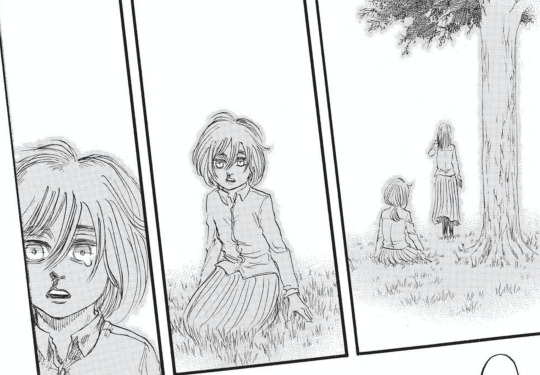
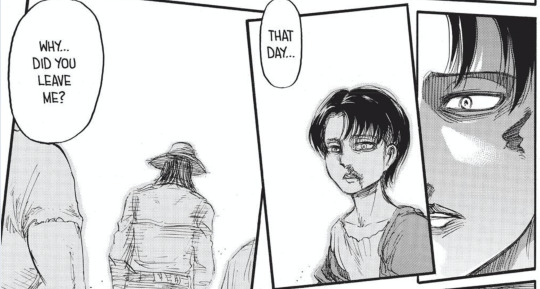
Both characters, although experiencing different forms of deprivation initially (Physical vs. Emotional Nourishment) were abandoned at crucial moments in their lives - when they were looking for validation from their primary caregivers and the people who should have been responsible for demonstrating affection. Historia was abandoned when, after reading and taking onboard information she read in books just like her mother, she reached out to hug her, and Levi was abandoned at the moment he demonstrated that he’d absorbed everything Kenny had taught him. The parallel between these images is very powerful.
Kenny is a character that highlights more parallels between Historia and Levi.
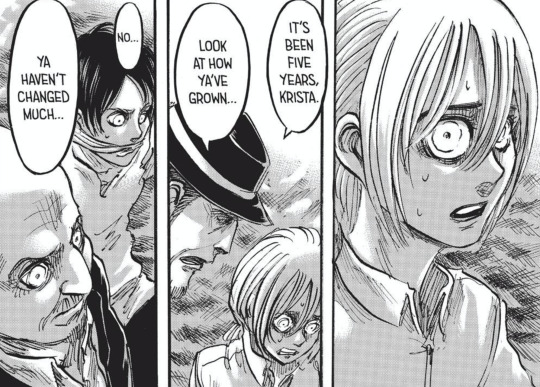
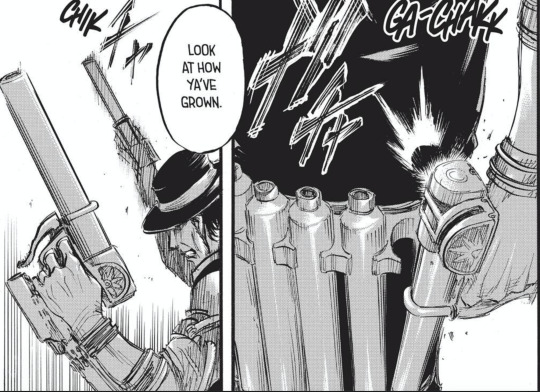
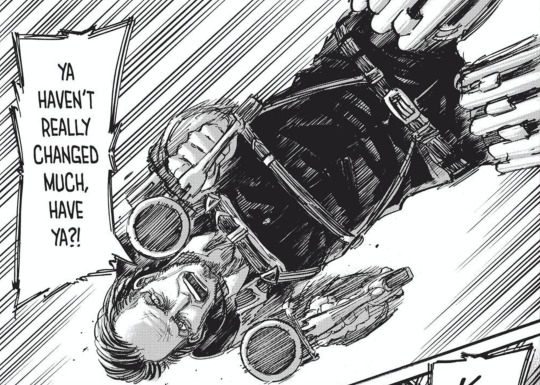
Kenny’s words highlight the literal lack of growth in height for both Historia and Levi - both are particularly short, and also look youthful - but we can also take the words to suggest that the characters are still very much defined by what happened to them in their pasts, and have yet to step away from their demons and achieve closure on what has happened to them as children.
At this point, we can definitely say that Isayama has chosen to tie both Historia and Levi’s stories together through their childhoods - their backstories are revealed alongside each other, in the same arc of our story, and in terms of experiences, they are both identical and mirror opposite at different points.
2. Shared Values
Despite being deprived of affection for large portions of their childhoods, both Levi and Historia appear to have experienced glimmers of kindness in their darkness as well, and this has shaped some of their values and behaviours.
Levi experienced his mother's love for a short while until he lost her - we know how deeply she cared for him from her refusal to give him up despite Kenny’s advice to her when she fell pregnant. Historia had Frieda’s kindness instilled in her, even though she's not able to consciously remember her actions until later.
Both display an affinity for animals, with several manga and even anime-only scenes where we see them being affectionate and kind to their horses. We don’t see this as prominently with any other characters.
But one of the biggest shared values is their desire to protect children. I've posted on this before, but here are a few examples of Levi being driven by this value:

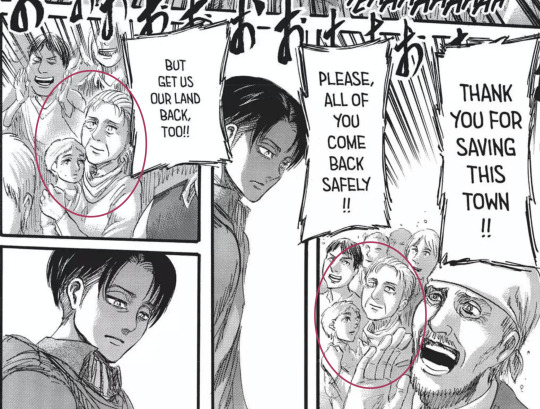
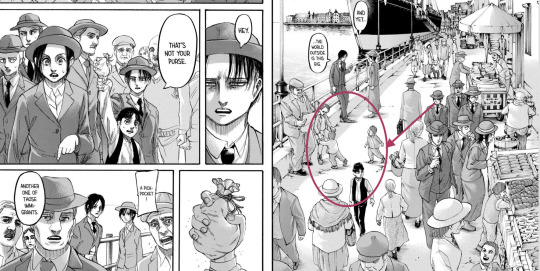

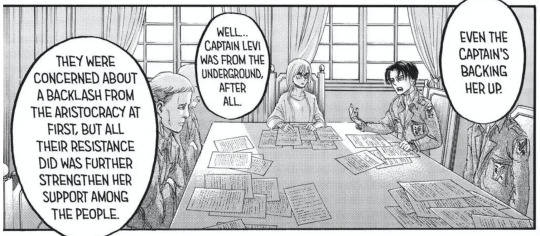
It’s clear Levi has a soft spot for children. And Historia? We know her feelings on children from her first action as Queen - realised with the support of Levi.
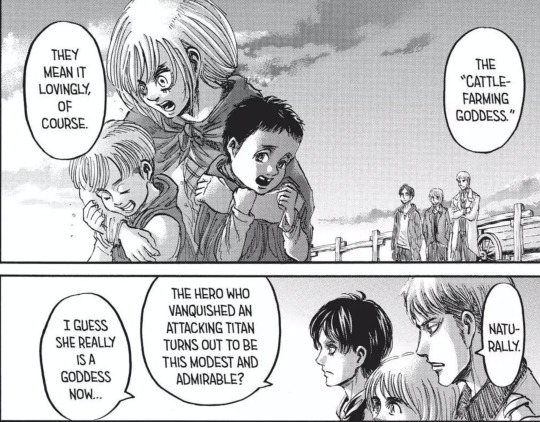
3. Kenny’s failure … Levi’s success?
These next scenes we’ll focus on represent the moment that Levi and Historia are set up to undergo that ‘growth’ Kenny was referring to earlier in the uprising arc. Note Isayama’s choice of words here, and the symbolism of the whole scene. Kenny doesn’t tell Levi, ‘I couldn’t be someone you looked up to,’ or ‘I wasn’t fit to act as your father figure,’ he literally says ‘I can’t be some kid’s dad.” What does he do then? He shoves the titan serum at Levi.
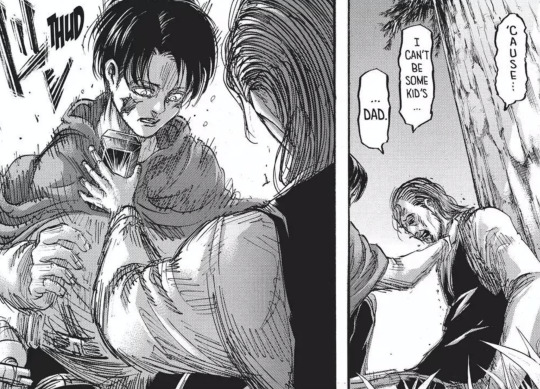
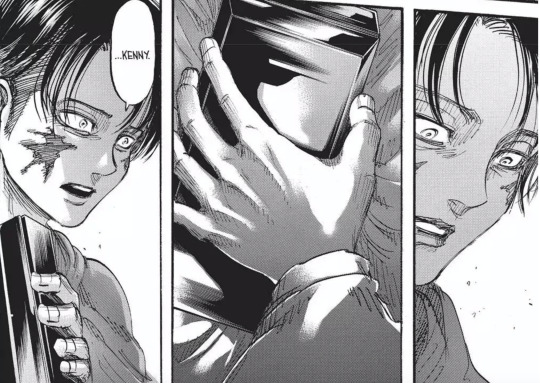
Isayama pays great attention to this - dedicating several panels to the weighty moment, and Levi’s expression. It’s very dramatic. Notice how the word ‘Dad’ even has it’s own speech bubble. It’s almost as though Kenny is passing the mantle on to Levi - passing that responsibility on to him. It feels as though the passing of the serum replaces the missing words, ‘but you can.’ Isayama didn’t have to have Levi ask that question in the moment before Kenny passed the serum on to him. He could have positioned it so that the discussion about dreams was the precursor to the serum being passed over - which in my head, for the context of the scene, would make more sense. But he didn’t; he chose to have Kenny say that exact line to Levi - to admit his inadequacy as a father figure, with that focus on the word dad - and then hand the item over to Levi.
By itself, the scene could be seen as highlighting the ways that Levi is already a better father figure than Kenny. He has been somewhat paternal in his role as a Captain. But it’s the very next scene that brings Historia immediately into focus.

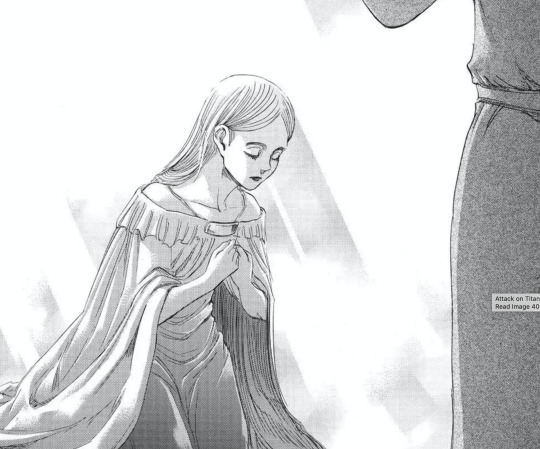
Historia looks suddenly so much maturer here, and the way the scenes sit immediately after one another feels too much like foreshadowing.
If you want the full effect of what I mean here, just rewatch this section of the anime!
We are presented with parallels between them once again. The focus of the crown and power of the monarchy being bestowed on Historia parallels the gift of the serum from Kenny to Levi - drawing on the ‘titan science’ element of the Ackerman heritage, perhaps?

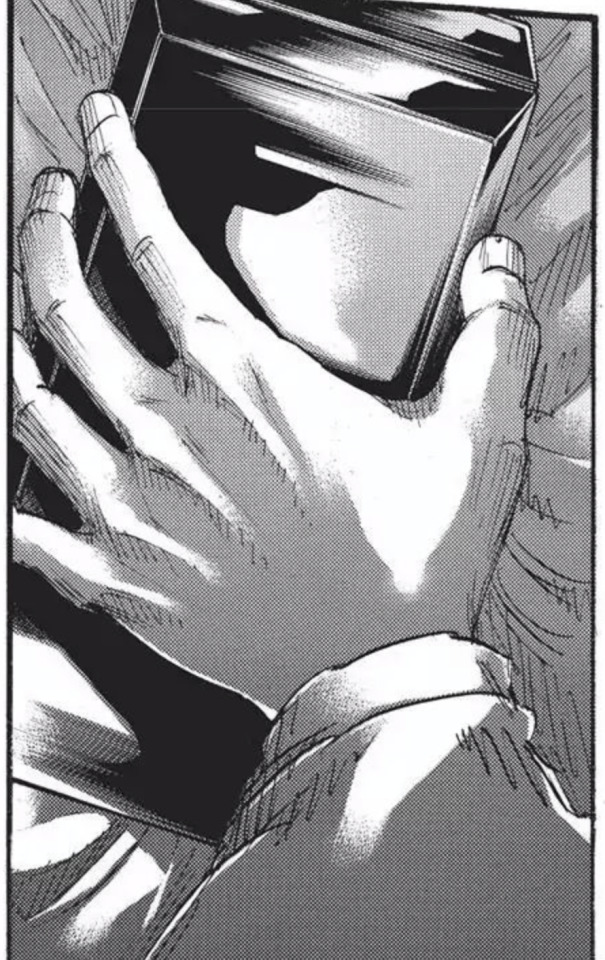
Let me take a moment here, while we have these two visual representations of the Ackerman and Royal bloodlines side by side so perfectly, to point out that Isayama chose to answer a question in Bessatsu Shonen Magazine regarding the nature of a child born of both these bloodlines in 2018:
Q: If a child were to be born between two people from the royal family and the Ackerman family, which blood would take precedence?
A: I think that both [of their bloodlines] would be reflected.
4. Blood Lines, Identity and Destinies - the Acker/Royal connection
We are still missing some information about the Ackermans, and Mikasa’s own Ackerman powers and behaviours have been a focus in recent chapters, prompting more questions. This suggests that the role of the Ackermans will be important in the story’s finale. With that said, lets have a look at what information we have about them so far in relation to the Royal Family:
- They worked closely with the Royal Family at one time, even being described as their sword and shield until they fell out of favour.
- They cannot be controlled by the king’s vow or have their memories tampered with. For this reason, they became enemies of the crown and the two bloodlines became at odds with one another.
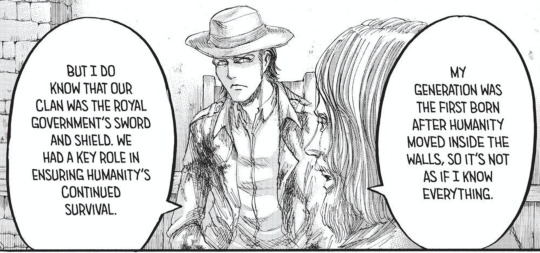
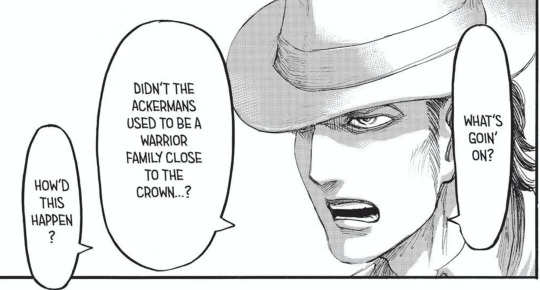
Do either of these scenarios sound familiar in a romantic setting? The knight and princess trope has been hugely popular in fiction for as long as stories have been told - Lancelot and Guinevere is a well known classic. And two feuding families finally brought back together through love by the younger generation? Romeo and Juliet, anyone?
Okay, so maybe I’m reaching here. But Isayama has opened the discourse around this connection between the two bloodlines without concluding it, so I am certain it will have a part to play in upcoming chapters. Why create two characters from said bloodlines with such satisfyingly parallel but awful childhoods, if not to use them in some way to conclude this part of the narrative in the future?
5. The Beast Titan.
Another common plot point that Levi and Historia have is Zeke. The Beast Titan is a defining element in both their arcs. Levi is driven forward by his vow to kill Zeke, and this is repeated to the point where we expect this to be realised, or at least to see some satisfying resolution between the two. Historia’s situation is defined by her vulnerability to being turned into a Titan in order to consume Zeke. This threat to Historia’s life as a normal girl is also repeated across the later story arcs, just as Levi’s vow and apparent destiny to face off again with the Beast Titan is. If we link back to the knight princess trope, we could suggest that Historia is the metaphorical princess, Levi is the metaphorical knight, and The Beast Titan is the metaphorical dragon. The dragon must be slain in order to protect the princess, and the one to do this is always the gallant knight, or the hero. We know that Levi has been labelled Humanity’s Strongest, and even a hero, before.

It has been Levi’s destiny from the start. What's more, what is the crux of Zeke’s plan for Eldians?
Euthanasia by preventing reproduction. Zeke’s ideology basically directly opposes the values of Levi and Historia - who wish to save as many children as possible.
6. The Smile

If there is one scene Levi fans lost their heads over, it’s this one. The Smile. Who was responsible for getting the sullen Captain to smile? None other than Queen Historia. The one time we get to see a genuine smile from him, in all 131 chapters of SNK, is when Historia playfully punches his arm. I think by this point, it is absolutely fair to say that Levi has a soft spot for her, although I’m not suggesting this is anything romantic at this stage due to her still being a child. What else is interesting about this scene? Let’s look at it from Historia’s point of view. She’s still a 15 year old girl. I’m hardly suggesting she’s got deep, meaningful feelings for a Captain so many years her senior. What I am suggesting, is that clearly there is the beginnings of her seeing him in a different light, and feeling some sort of fondness towards him too. This is also the stereotype of innocent, youthful infatuation - how many times have we seen teenagers play-fighting or bantering with the object of their affections? Something might just be stirring in Historia towards the Captain as she begins her transition into adulthood.
7. THAT (deleted) Scene
Okay, so we can’t very well talk about the smile in the context of this topic without addressing this scene:
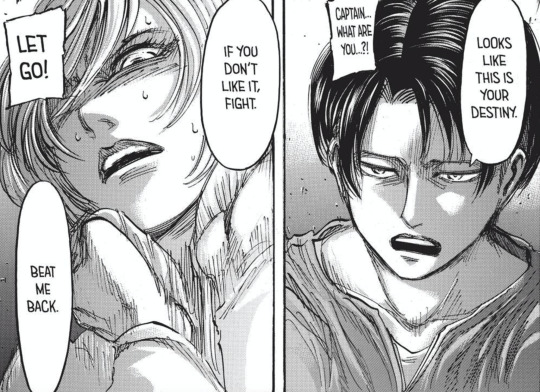
There were a few scenes cut to make the uprising arc in the anime more streamlined. This is one of them, and again, has been one of the most talked about. People either love or hate this scene. In the manga, it absolutely sets up some major character growth for Historia, when she goes from being scared and allowing Levi to threaten her into taking an action, to standing up to him atop the wall at Orvud district, throwing his own words back at him. In contrast to Historia’s willingness, Levi becomes more receptive to her perspective and backs down, which also shows his growth. (More on that shortly!)
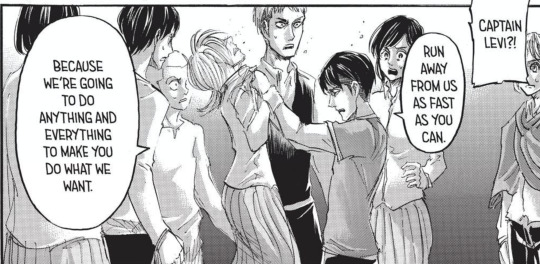
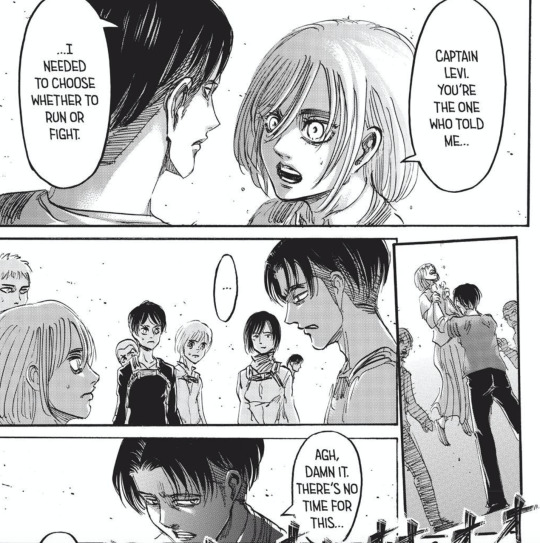
So, if it adds to the narrative around Levi and Historia, and is a key part of their development as characters, why did Isayama let the studio remove it? It must be because their influence on one another’s growth is no longer important to the story, correct?
If you ask me, that couldn’t be further from the truth.
Isayama has stated there were some elements of Uprising that he was unhappy with. Just, for a moment, think how this scene would fit into the bigger picture of a relationship (whether that be deeply platonic or even romantic) between Historia and Levi. Could people get behind that knowing that once, he handled her so roughly? Does keeping this scene as canon for the anime open a can of worms in terms of what is and isn’t acceptable (even more so than the age gap already does) when it comes to a relationship? Could Isayama be seen as glorifying abuse and suggesting that female characters are likely to develop feelings for men who have treated them so poorly in the past? I completely understand Levi’s reasoning for acting this way in this scene, and I loved the set up and pay off later in the arc. However, I do believe that animating this, and then having them become much closer later in the story, could make a backlash likely.
My conclusion to this particular section is - if their influence on one another as characters was unimportant, and the payoff of them reaching a stage where they bring out the best in one another wasn’t relevant to the rest of the story, then The Smile shouldn’t have made it in, right? So much of the set up was removed that it would have been far easier to scrap the scene than to try and figure out another reason for Historia to punch Levi, and make him smile.
That punch was important. It remains for a reason.
8. Levi’s Echo
So, since we discussed the impact of Levi’s words on Historia in the previous point, and how Isayama uses them to illustrate her character growth, let’s jump ahead all the way to chapter 130. We’re now post time skip, where Historia is nineteen. She’s matured now into a young woman - a woman old enough to acceptably conceive a child. This is the chapter which caught everyone’s attention due to Historia’s words to Eren regarding the idea of said child. But first of all, I want to focus on a scene which appears a couple of panels before her question:
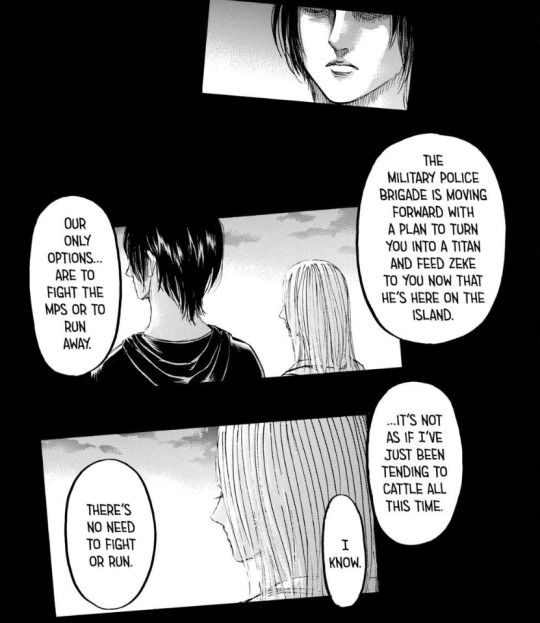
‘It’s not as if I’ve just been tending to cattle all this time.’
What does this line mean? The only thing we know in terms of what Historia has been doing in the time skip is that she set up an Orphanage that Levi was also very much invested in and supported her with. So she’s not only been tending to cattle, but ... tending to orphans? With the Captain’s help?
Remember how we said that Isayama doesn’t include subtle details unless there’s a reason. Having Levi support her with the orphanage as a way to show how much he cares about the poorer children wasn’t needed - we already know from several instances discussed earlier that he cares about that topic deeply. So surely this must have been a small detail to set up for a later reveal?
This line alone is interesting, but not necessarily enough to suggest a big influence from Levi. But it’s the next line that grabs attention:
‘There’s no need to fight or run.’
What does this echo?
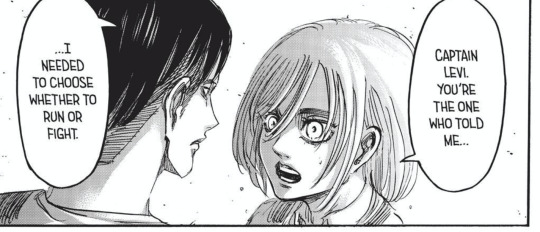

In my mind, the reason served by this dialogue in 130 is twofold. It works with both the literal events of the deleted scene, and also with the reader’s knowledge that the scene was disregarded later:
1. There is no reason to run or to fight, because Levi is on her side now. When he originally spoke those words to her - run from me or fight me - they were used in reference to what he and the corps were going to make her do - ie, become Queen. Now, they are not forcing her to do anything - they aren’t making her comply with the 50 year plan of producing as many royal children as possible and turning herself into a titan. Instead, she’s empowered by them, and very importantly, him, to make her own decisions while they try to figure out an alternative. (Why do I say him? I’ll cover this in the next point). And yet ... she still chooses to bear a child. A child born of love, not necessity. This is the difference between the birth of her child, and her own birth. And funnily enough, Levi’s birth, too.
The cycle of history is being broken.
2. Her words serve as a reminder that in the revised version of events, Levi never even forced that choice upon her in the first place. He’s always been her ally and treated her with care and respect. Even more reason for her to value and care for him in return. There really is no need to run or fight - from the military police, because she will bear a child, stopping them from turning her - or from Levi, either.
9. The Hooded Figure
As promised, let me explain why I say that Levi empowers Historia (yet again) to make her own decisions. My good friend Key made a wonderful discovery regarding the hooded figure panel, and honestly, based on the evidence I’ve seen, I’d be prepared to bet a whole lot on this next claim:
Levi is the hooded figure who warned Historia of the plan to turn her.
I’ve shared Key’s original post previously, but here’s the gist, with some added observations.
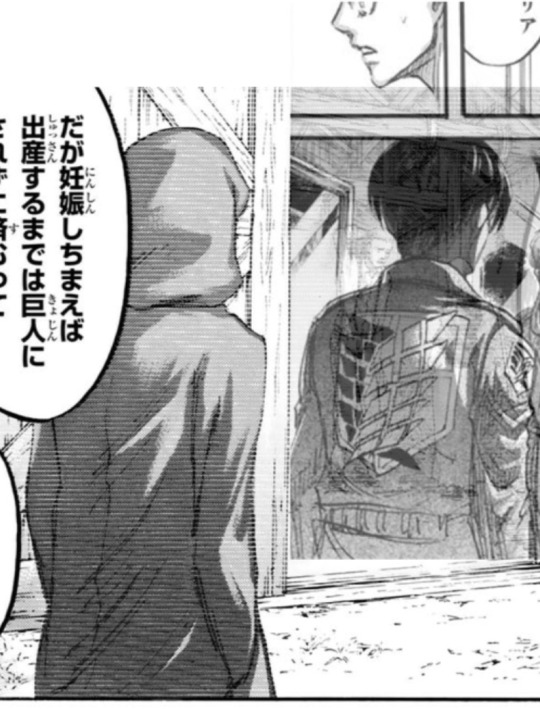

Levi from the hallway; Levi from that iconic scene, fits the dimensions of the hooded figure perfectly, without having to adjust the panel sizes.
The jacket worn is lighter in colour than Eren’s standard black one, but is reminiscent of the jackets worn by the Levi Squad in the uprising arc. The only other clue we’re given to work from is that the figure has their hands in their pockets.
Hmm ... you know who else has a habit of stuffing his hands in his pockets?
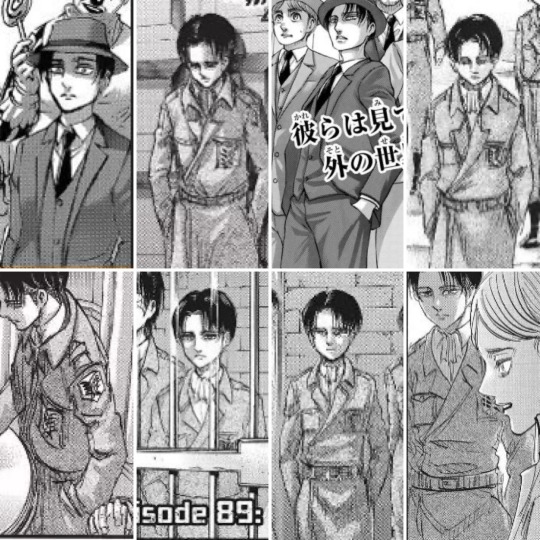

So if Levi is the one who warned Historia, is that why she subtly uses his words when talking to Eren?
Let me return to chapter 130 once more, and just invite you to read the following panels from a different angle.
10. Mikasa-Eren/Levi-Historia Parallels
Alright, so this is a bit of a head-mash, but just consider what I’m about to say. In our panels with the Historia-Eren-Zeke conversation, Mikasa is never mentioned by name once. Zeke mentions ‘this Ackerman girl,’ however there is no confirmation that Eren was in fact talking about Mikasa when he asked Zeke about the Ackerman traits ...
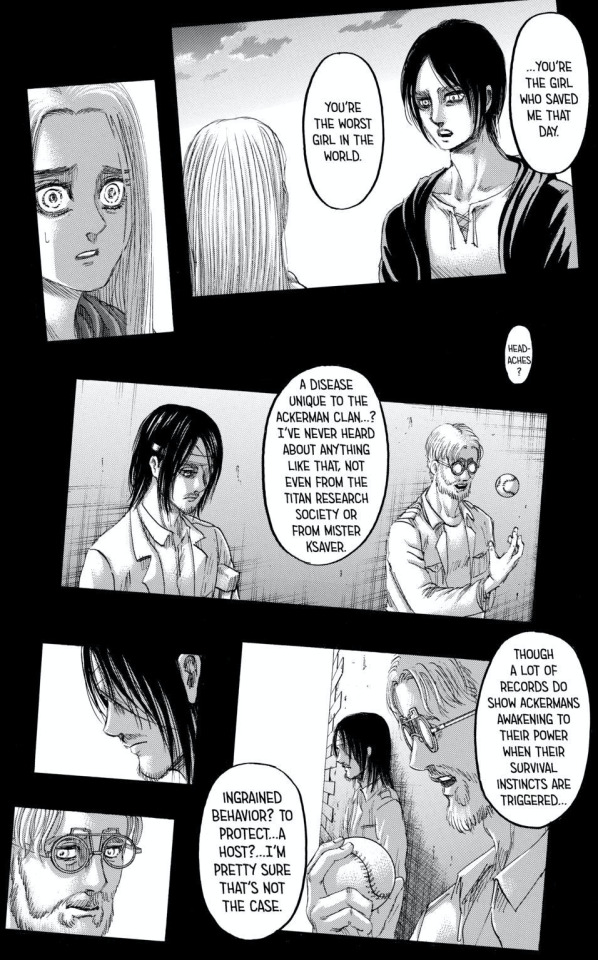
Isayama only shows us the conversation with Zeke after Eren has just spoken to Historia about her fate and what the Paradis government want her to do in terms of bearing children. If these are just all memory fragments of Eren’s, why would discussing this with Historia suddenly make Eren think of a conversation about Ackerman traits with Zeke?
In this conversation, Zeke puts two and two together and gathers that Eren is asking these questions because of Mikasa. He then tells him how much Mikasa obviously cares about Eren, regardless of any ‘ingrained behaviour.’ What does Eren then link this with?
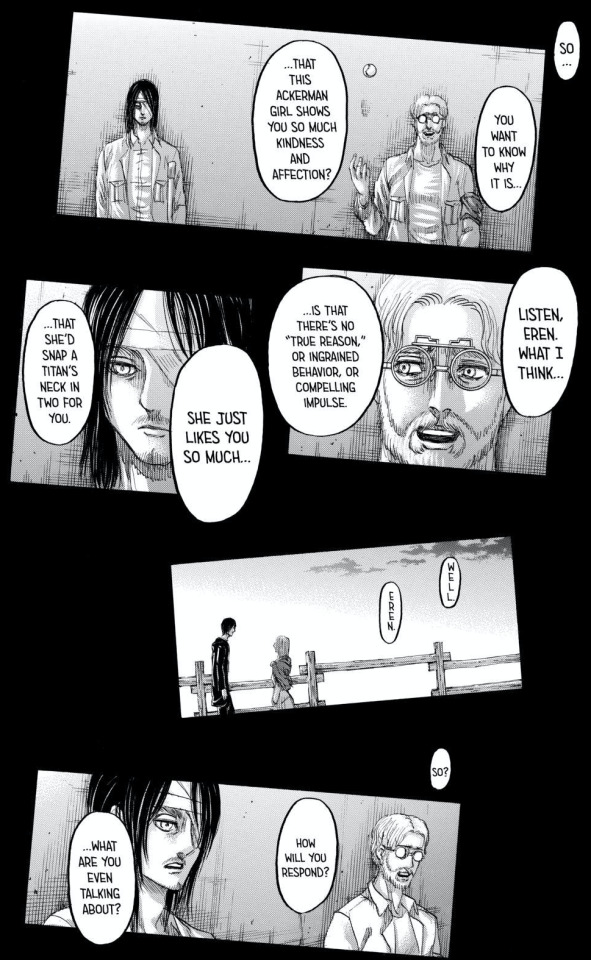
The conversation where Historia asks him what he’d think if she was to bear a child. What does ingrained Ackerman behaviour and Mikasa’s true feelings have to do with Historia’s child?
I want to suggest this possibility: this conversation has nothing to do with Mikasa’s feelings for Eren, and everything to do with Levi’s feelings for Historia.
Eren even confirms that Zeke has the wrong end of the stick with asking him how he will respond to Mikasa’s feelings.
What are you even talking about?
Here, he is not considering how he will respond to Mikasa, because he can’t even contemplate that with what he is about to do, and how long he has left to live (although this may have then prompted his later conversation with Mikasa after the market - where he sees Levi save the boy that he will later kill - do you see how this is all linking together?)
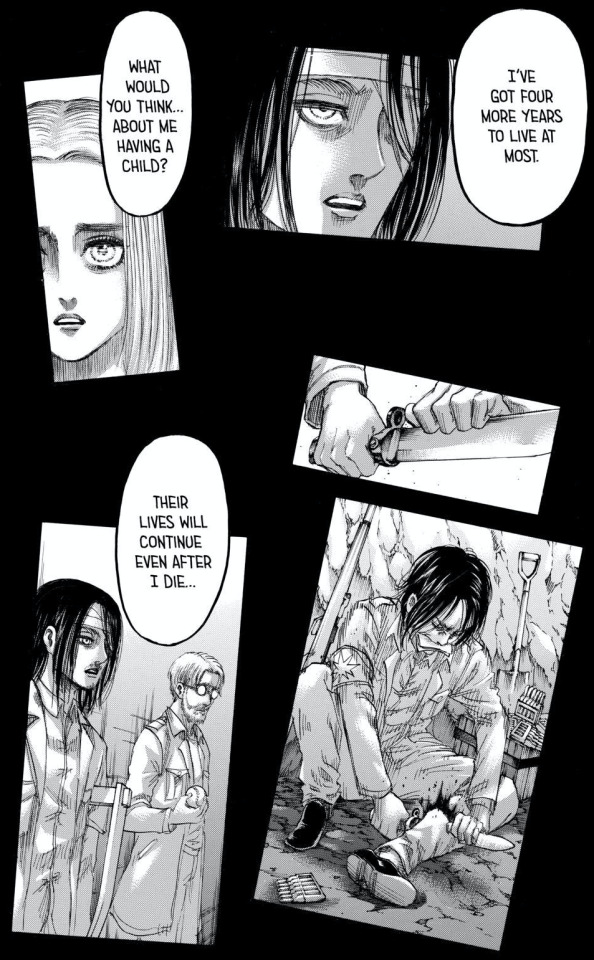
Here he means the lives of Historia, her child, and potentially even Levi, as well of course as Armin, Mikasa and the rest of his friends. Want to know why I think that? Isayama hinted it. Again.
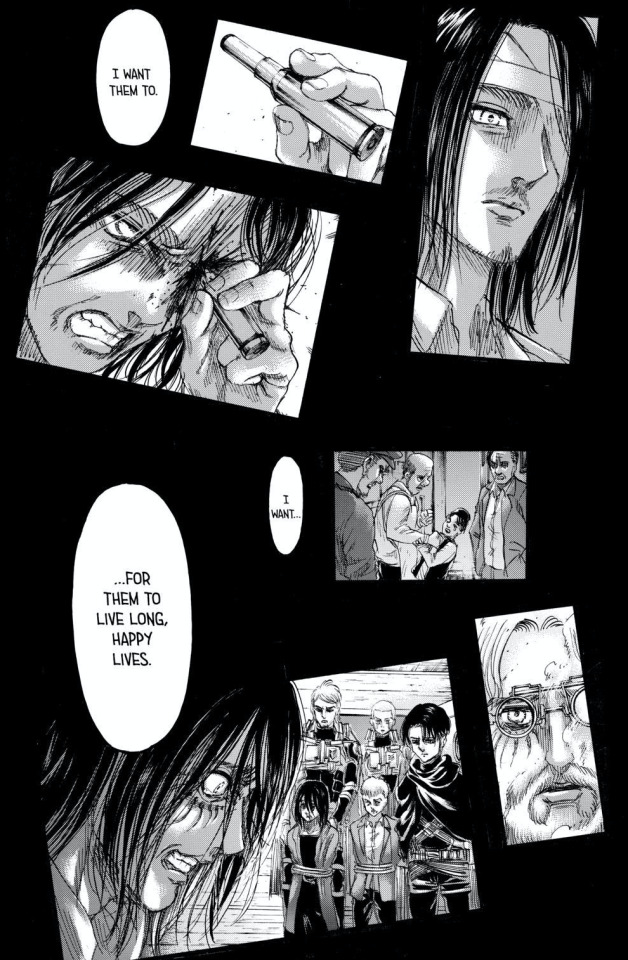
We have the image of Historia, suggesting the idea of bearing a child, followed by the image of the child Levi saved, followed by the image of Levi himself.
Isayama draws every detail in every panel for a reason. If part of his conclusion to this manga involves Levi and Historia intertwined and the birth of an Ackerman-Royal child, it won’t be a massively random idea.
It will contribute to an ending where the clues were there all along, but we never really considered them.
(There’s more, so much more, but I have to stop somewhere or I won’t leave my computer. If anyone wants a part two because you’re thirsty for more of this crap, drop me a comment!)
#Shingeki no kyojin theory#attack on titan theory#snk manga spoilers#historia reiss#Levi ackerman#Historia dad theory#Historia pregnancy#royal Ackerman connection#snk chapter 130#snk theory#aot theory
294 notes
·
View notes
Text
The "Rapunzel" is a Lie in Run On
My favorite theme of Run On is that it is up to you to make your own happiness in life and that you have the full autonomy to do so, no matter what anyone else says. And my favorite ways the way the drama shows that is how a) that for your own happiness you must put yourself first in your own life, b) building a personal found family with real, caring relationships is important, and c) cherishing both yourself and your found familial relationships together is key to creating a truly fulfilling life.
The idea of a Rapunzel is mentioned a couple of times in the drama, and in a way, many of the characters could fit the role of a "Rapuzel." Seongyeom, Danah, and Woosik have all been stuck in their own lonely "towers" based on society's "rules" and expectations about how they should conduct their lives. And while they all have had someone come into their lives that has made a profound impact on them, none of these people had a Prince/ess Charming swoop in and save them from their lonely towers. Instead, their prince/esses have only been catalysts for change. They may have opened the door for the Rapunzels and encouraged them out of their towers, but in Run On, the Rapunzel has to make the active choice to leave their tower. Only by their active choices to redefine their relationships with themselves and with others are they able escape the confines of duty, obligation, and expectation and learn to live life and build meaningful relationships for themselves.
The drama started off with a lot of relationships based solely on pretense only, as if circumstances are what make strong bonds. But as the episodes go on, it's demonstrated that it's not the obligation of a powerful relationship that defines the strength of a relationship, but rather the relationship strength is determined by the actions a person takes in the relationship. In the beginning, we have Seongyeom surrounded by "strong relationships," a picture-perfect successful family, an elite track team with a renowned coach, and a sports agent that gets him in photo shoots and in the press. But as we delve past the outside illusion of these relationships, we see a family that is mostly absent from each other's lives, teammates and a coach that at best Seongyeom leaves at arms length, and at worst actively talk and scheme behind his back (and do even worse to Woosik), and even Danah barely knows Seongyeom on a personal level and openly admits their business relationship is used for her personal gain. Danah is in a similar situation where most of her obligate family/business relationships are trash as well, even if they look great from the outside; and she openly admits she has no friends either. Woosik is the lowly hoobae in his track team that doesn't have enough social capital at the time to stop his bullying or get the coaches to stop looking the other way from his bullying. All of these dynamics are based on the idea they must sacrifice parts of themselves for the greater (fucked up) system at large.
Then Mijoo enters the story. As an orphan she has had to build a found family for herself her whole life. Because she has none of those pre-determined familial obligations, and is a freelancer with no business to ruin outside of her own, she isn't beholden to the same rules of conduct that seem to be holding down Seongyeom, Danah, and also Woosik. Because she had to survive on her own, Mijoo learned early on that let herself out of her Rapunzel tower long ago. Waiting for someone else who might never come wasn't going to put the proverbial self-worth food on the table. Instead, she went out and foraged for those found family relationships herself.
The other great thing about when Seongyeom confronted his father was that it wasn't because Mijoo said anything about what his father had done or that she had encouraged any specific action in that case. Again, there's no "damsels in distress" here with a hero ready to take control (the "Rapunzel" is a lie!), it's about seizing your own life for yourself. Mijoo may be "[Seongyeom's] strength" but the way he stood up to his father in a way he never has before was done alllll on his own. Seongyom, the guy that was once considered "shameless" because he felt no embarrassment in the past when he did things is now actually feeling real shame and embarassment at how his father treats the people Seongyeom holds dear. The portrayal of a loving relationship resulting in self-actualization and autonomy an incredibly beautiful sentiment that isn't really portrayed in romance stories, at least not as explicitly and openly as it is in Run On.
The other thing I want to touch on is the running theme of embracing found families in lieu of obligate families in Run On. At the beginning of the story, Mijoo, while a bit of a loner, has a demonstrated strong relationship with May, and as the story goes on, we see most of her business relationships are also real friendships based on warmth and sincerity. That same sincerity is brought on as her relationship develops with Seongyeom and as she makes friends with Woosik, Younghwa, and even Danah (Mijoo's quips to Danah may be biting but they are sincere, haha). As Seongyeom learns to build his own sincere relationships with his own found family, we also see him bloom from someone with a husk of a social net, a person who barely ever put himself and his actual emotions out there, to a person not only with strong convictions for others but convictions in his actual relationships with others. He lets himself care for others and in turn that opens himself up to the genuine care others have for himself as well.
My favorite scene demonstrating this is after Woosik's training session when Mijoo and Woosik were sitting next to each other looking over the footage. Seongyeom looked at them, not with the detached observation he would have had in episode 1, but with a bit of jealousy tugging at his heart because he wanted to be included. And then he actually expresses he wants to be included, something that would not even cross the mind of the old Seongyeom to want or express. And Mijoo and Woosik's response? They immediately met Seongyeom with warmth, and they not just let him sit down, but sit with them. Like they literally moved and made room for him between the two of them as if it was nothing. Because unlike any relationships he used to have, Seongyeom being included warmly is a given with them. They have such a natural affinity for him, that they just automatically folded him into their interaction. It was such a small scene but it really demonstrated the growth these characters and their relationships have had. There's no room for jealousy here, but there is room for Seongyeom.
And lastly, Run On drives home the importance of cherishing both yourself and the people you care about in tandem for a fulfilling life. In episode 12 we have the scene when Mijoo told Seongyeom's father that Seongyeom is not an object that parallels when he in turn told his father that his sister and Mijoo couldn't be treated like objects either. Neither Seongyeom's or Mijoo's self-worth is defined by the other person standing up for them, hell, they didn't even know each other did that. But just knowing you have that emotional support in your life is a comfort that both Seongyeom and Mijoo know what is like to live without, which makes their convictions even stronger. They've felt life without that support so they do not want the people they care for to have to continue to be treated that way. Nobody deserves to be treated as a pawn in someone else's life. And they can both boldly stand up against this treatment of their loved ones because of their self-actualization (or at least partial self-actualization, they're not perfect) in how to extrapolate their self-worth and tie it into their strength of care for others.
What else is interesting is that at the end of episode 12 when Mijoo is upset because of her verbal tussle with Seongyeom's father, I thought we would get a parallel to Seongyeom in the beginning of the series, where Seongyeom sacrificed himself for others, he was always putting himself second. But in a poignant reversal, she broke up with him not as a sacrifice for him, but for herself, because she is the most important in her own life. This is due in part because she still has that automatic defense mechanism that she can only rely on herself in tough times. That defense mechanism of relying only on herself, however, also has the beautiful reversal of that she knows that she has to work through shit herself to make herself happy. A double-edged sword mounted in a hilt of self-worth.
"Must I continue seeing him at the expense of myself?" Mijoo says. Of course we know this is an emotional strawman argument but I love that Run On has a clear message that having to hide yourself in a Rapunzel Tower for a "caring" relationship means that relationship isn't based in care at all. She also says, "I value myself more than anyone else." Mijoo can't sacrifice herself for Seongyeom's toxic relationship with his father (not that Seongyeom is asking her to, but as an orphan she feels guilty for "coming between" Seongyeom and his father even though she is at literally 0% fault in that relationship mess). Younghwa won't change who he is for Danah, and in turn Younghwa doesn't expect Danah to put him before her either. Woosik can't let his self-doubt change him into someone who has no drive. Now that he's letting himself believe in his ability to recover, he has a better support system than he ever had in his former track team. And as far as Seongyeom is concerned, even all of friends, his new found family, (Woosik, the other track dude, Younghwa, and the former track coach he brought back to coaching) take his personality and his friendship for what it is, none of them are trying to change his personality or mold him into something he's not. They've all actually expressed acceptance and affection for his personality quirks.
The isolation of a "Rapunzel" state-of-mind is being dismantled for all these characters in Run On, and it is immensely fulfilling to see the characters grow as they leave their societal expectations behind and form fulfilling lives for themselves filled with people who love and support them. Self-actualization at its finest.
#run on#kdrama#meta#my meta#heh this started out as a 5-sentence-long post about the post-workout jealousy scene and spiraled#i have meta control problems lol#also i'm including seongyeom's bio sister as part of his found family bc their relationship is now an active choice#long post
55 notes
·
View notes
Note
I'm going to have to disagree with you about Weiss's "go to your room" being childish. It's a callback to Jaques doing the same to her several seasons ago. Weiss is unconsciously or deliberately mimicking Jaques the second she has a position of power over her own family. That is not childish. It is horrifying in it's implications even if I do understand that RT meant it as a simple joke.
That’s true. I’d forgotten we’d gotten that line from Jacques (Volume 4 perhaps?) which yes, creates a rather distinct parallel once we recall both moments. Initially, I had read it merely as the “funny” moment RT seemed to be going for: Weiss sends her (perceived as) annoying younger brother (who’s not THAT much younger) to his room like a little child, she’s not smiling, but it’s supposed to be “funny” to the audience who wants to see “bratty” Whitley get what he “deserves.” Which, as you say, isn’t funny and that’s before we chuck in the issue of Weiss mimicking Jacques the moment she’s the head of the household.
Which, I want to be clear, doesn’t make Weiss an abuser. In fact, it makes a great deal of sense that she would repeat things she’s heard and experienced in the manor, likely subconsciously, and if that moment had been ALL we’d gotten, then Weiss’ hug this episode would have been a demonstration of growth. She might make some mistakes due to her abuse (and, you know, being human) but what distinguishes her is that she ultimately does care for her brother and ultimately does demonstrate that care — even if it took her longer than it should have. It also took Weiss longer than it should have to stop being so overly racist towards the faunus, but that’s the point of a heroic character: to watch them grow.
My problem with these scenes is that the “joke” is in combination with everything surrounding it: Weiss initially dismissing Whitley despite her mom begging her not to forget him (she was reminded to be a better person all of a day ago), her unwillingness to reach out perpetuating other problems (Whitley had a way of contacting a doctor this whole time. If Weiss had bothered to talk to him, Nora might have gotten care sooner), the incredibly iffy foundation this care seems to be built on (what happens if Whitley suddenly does something Weiss doesn’t agree with? Will her love automatically be revoked?), and the fact that she started all this with a very dangerous weapon pointed at his face. I don’t care whether RT intended us to take that seriously or not, I’ve always taken it seriously because textually there’s no difference between her threatening Whitley with a serious expression, threatening the Ace Ops with a serious expression, or arming herself when someone knocks at the door with a serious expression. What this tells us is that Weiss was prepared to use violence against (and absolutely used the threat of violence against) her brother, just as she would those she considers her enemies... and that’s a far larger issue than, “Weiss subconsciously mimicked Jacques while ordering Whitley to do something harmless and then later fixed that behavior.” This wasn’t harmless and thus it needs to be addressed, both the behavior itself and the underlying feelings that led to it: Namely, why Winter was able to see the good in Weiss despite her own flaws, but both sisters never seemed to try and nurture Whitley the same way. We can’t just erase Weiss (and Winter) ignoring their brother, dismissing him, and then threatening him with a scene that at its core goes, “Oh you’re useful! I love you now.” At the end of the day, Weiss had numerous chance to extend a hand to Whitley and she only did so once he’d proven that he could benefit her somehow.
We see the same issue with Ruby only thinking about breaking Qrow out of jail when she’s feeling directionless. Yang not giving a thought to her sister, the one she fought with and who is worried about her. The group all the way back in Volume 6 raising their weapons against Qrow for saying, “Hey.” The cruel dismissal of a man crying on his knees and then forgetting about him for months. Continually, I’m told by the story, “These characters all love each other!” but they often have a very strange way of showing it — and not in a way that the story intends to grapple with because they’re complex human and make mistakes.
...In retrospect though, this paints Team YJR in such a nice light. I mean, I still think it’s weird that we went from “Oscar who?” to “Who cares about Atlas? We need to save him!” with very little development in between (let alone any acknowledgement of the ethics here), but I’ll take feral Ren doing everything to save his farm boy over many of these other relationships.
35 notes
·
View notes
Note
Hi,I heard there are some Avatar The Last Airbender fans bashed Katara for being hostile towards Zuko when she has a valid reason to do so given what he did in Crossroads of destiny,do you validate Katara’s grudge and animosity towards Zuko?
Hello, Daily-Zuko here!
Though I’m not sure what answer you’re looking for, I suppose I’ll do my best to respond in a nonjudgmental manner. You’ll have to forgive me – as a Zuko blog, my focus in this breakdown skews towards him, though I have tried to give sufficient attention to Katara as well. As this turned rather lengthy, the majority of the content lies under the cut. Thank you for the question.
I think my favorite part about Avatar: The Last Airbender is its nuance in exploring complicated character dynamics. There is no black & white morality; each character’s feelings are treated with as much delicacy and respect as they deserve. Every individual’s story is weaved together seamlessly to create a greater whole, and Katara and Zuko are no exception. Their character arcs run parallel in many ways during the show, finally colliding in the Season 2 finale. They have both struggled with grudges, rage, and resentment holding them back throughout the course of the series, and this culminates in the climactic turning point in The Crossroads of Destiny.
Katara, after carrying the pain of losing her mother for so long, seemingly finds a kindred spirit in Zuko, and let’s go of her anger to extend a hand in trust. This is her attempting to move beyond her childhood trauma to start healing. Zuko’s rejection of her is a rejection of his own inner turmoil, but it unfortunately cements Katara’s toxic mindset of revenge. Regrettably, Zuko is not ready to accept a change of heart; this occurs just as he’s evaluating his own moral stance. This finale subjects both of them to their lowest point moving forward.
To answer your question, I believe that the actions they both take in The Crossroads of Destiny – and beyond – are valid.
At the point in the narrative where Zuko attempts to join Team Avatar, Katara’s potential growth has been stunted from their previously aborted connection. Zuko’s mental scars from his mother were not a central theme to his character development, unlike Katara, so he was able to complete his metamorphosis and advance. Though to all appearances they share the same childhood experiences, in terms of character, they do not share the same Ghost.
In the book Creating Character Arcs, by K.M. Weiland, the author outlines four distinct things to establish in order to successfully create a Positive Change Arc: a character’s Want, Need, Lie, and Ghost. Zuko’s want versus his need is rather obvious. The lie he believes is that his worth is tied to his father and his title. By capturing the Avatar, he will return home and become intrinsically complete. The ghost, in this instance, does not refer to any literal ghost; rather, the ghost is the incidental wound within a character’s past that causes the character to believe in the lie in the first place; in other words, the Agni Kai.
In contrast, Katara’s ghost is literal – the death of her mother. It haunts her and prevents her from understanding her truth: that continuing the cycle of war will not remedy her grief. This creates an opposing force for their conflict in The Crossroads of Destiny, as while Katara has yet to confront her own lie, she is presenting Zuko with his truth, and rushing him into the next phase of his archetypal growth.
Zuko’s choice in this scene is necessary. His reaction to Katara’s unexpected offer of reconciliation is instinctive – primal. Though he has come to the point where he can question his way in life, he is not yet ready to have this outlook thrust upon him in this split second decision. He cannot confront his lie. Therefore, he rejects the truth, relapsing based on what all previous experiences tell him is correct. Only once he fulfills his want in succeeding does he realize that it is not what he wanted in the first place.
Additionally, Katara is somewhat of an unfortunate bystander in Zuko’s next step on “The Hero’s Journey.” The Positive Change Arc quite commonly coincides with the much earlier interpretation of character development defined by Joseph Campbell in The Hero With a Thousand Faces. Though this path is generally a commentary on the main character’s quest, this is only because other characters are not usually as fleshed out. Zuko, as the deuteragonist, is an exception. In this stage, referred to as “Challenges and Temptations”, “Road of Trials”, “The Descent to the Abyss,” etc, Zuko needs to fall to the absolute bottom in order to die and be born anew, and he drags Katara with him.
In this vein, Katara’s obsession with rage and revenge simmers within her, and is not addressed in detail until The Southern Raiders. It is something that was magnified by the perceived betrayal of someone she had faith in, but it was an underlying issue that colored several actions she took. This was, of course, exacerbated by the duplicity demonstrated by others throughout the series.
During their stay at the Western Air Temple, Zuko doing all he can to show Katara his changed self even though she continually rebukes him is his only meaningful way to absolve and prove himself to her in spite of his previous violation of her trust. His acceptance into the party does not erase his past mistakes. Katara needed to shun him just as Zuko needed to show her, with his actions, that she is allowed to forgive and finally complete her own journey. It is a fragile balancing act the writers have coined in order to give these two the catharsis they deserve, and it is executed flawlessly.
.
.
.
tl;dr: Yes, Katara is valid, so is Zuko, this show is more complicated than that and implying that one character (on either side) is in the wrong somehow for their feelings does a disservice to the show’s excellent writing.
Additional youtube content from people who articulate much better than I do:
The Importance of Mistakes, by Make Stuff
A four-part show analysis, from The Weight of Cinema
The Cycle of War, by Hello Future Me
And finally, thank you to my lovely beta @tmariea for constantly helping me put my thoughts in order.
179 notes
·
View notes
Text
Yoruichi and Co. & Kaien (Part 2)
Last time, in Part 1, I seemed to have exhausted Tumblr’s ability to nest images in a text post. So, let’s finish this up on this go-around:
Rukia & Kaien and the Hōgyoku
@mysteriousshopkeeper had a post fairly recently entitled Urahara’s Motive, Means and Opportunity for Suppressing the Hōgyoku, about why Kisuke chose Rukia as the host for the Hōgyoku. Within was the conclusion that she was chosen because, “I think she was most likely just a target of opportunity.” Our thinking (as we discuss these things regularly) has somewhat advanced since then (as evidenced in the post His Research), but given all the above, it has an even simpler explanation, given in chapter 268:

Rukia is—quite simply—Kaien’s final disciple, inheritor, heir, successor, protégé, or whatever else you want to call her, and thus the most recent and also purest of them. (It’s easy to see that Yoruichi and Kisuke, given the demands of the Onmitsukidō and 2nd Division, were likely at least partially corrupted, tainted, or compromised by their experiences, in a way which Rukia would not be.)
If you take it for granted that Yoruichi was heavily influenced by Kaien (which I think has been well-demonstrated), it would make sense that the same be true of Kisuke. If that was indeed the case, his selection of Rukia on the basis of her holding Kaien’s heart would make complete sense. But what other proof of this do we have...?
Kisuke and Yoruichi & Ichigo and Rukia
As early as chapter 48, during the fight with the Menos Grande, Kisuke indicates he already conceives of Ichigo and Rukia as a team:

Rukia’s efforts to try and save Ichigo here are, incidentally, another parallel with her trying to save him in the way she couldn’t save Kaien (as are her efforts to involve herself in the Grand Fisher fight, and her efforts to save him from Renji and Byakuya). However, Kisuke prevents her from doing this not just so that she can witness Ichigo’s growth, but so that she might grow herself. This will ultimately only be fully realized when Ichigo saves Rukia from the Sōkyoku, but you can see that he had already placed tremendous faith in them. Why?
It doesn’t make much sense... unless you accept that he believes that together, they are the true inheritors of Kaien. (The Sand and Rotator mimicking what Kaien promised, if you will). This is most obviously affirmed with his infamous ‘deathbed speech’ in chapter 666:


But other examples of it abound. Most (if not all) of these are focused on Ichigo, such as this example from earlier in chapter 48 (where Kisuke notably completely ignores Uryū, much as Yoruichi earlier ignored everyone but Ichigo):

Or this example from chapter 518:




Where Kisuke rebukes Chad (and Orihime, who is notably silent and thus seems to share his doubts about Ichigo) for not believing in him sufficiently.
Yoruichi’s input on Ichigo is more limited (and she has none on Rukia, which is bizarre given their similar history) but she clearly goes along with Kisuke’s general plan, and she articulates her thoughts directly to Renji during Ichigo’s bankai training in chapter 137:

Her rather carefully chosen and almost hesitating words here lead one to believe that what she’s saying is something of a cover, don’t they? Even still, note her words, “I believe in him.” Yoruichi never says that directly of anyone or anything else.
Taken together, I think it’s very hard to refute that Kisuke and Yoruichi have an unshakable belief in Ichigo and Rukia (even if it’s rather unstated in the latter’s case). A belief that they will do the right thing—like Kaien would’ve.
Rukia and Ichigo
So what do Rukia and Ichigo believe in anyway? What makes them, as @mysteriousshopkeeper put it, Kisuke’s “Chosen Champions”? The answer given would suffice: “And what do they have in common? Compassion. Ichigo is fiercely protective to those who can’t protect themselves, and even wants to reform Soul Society.* Rukia believes it is a shinigami’s duty to protect every conscious soul.” This is true enough, and they tell us as much in chapter 2:






Ichigo makes it clear that he doesn’t believe Rukia just helped him out of duty (and likewise, it’s clear she didn’t just help him because he resembled Kaien), but doubts his own commitment. (This is the same commitment Chad questions later in the manga, which Kisuke believed in absolutely.) Ichigo gives a few additional remarks in chapter 48:


These demonstrate the degree to which his desires to protect had expanded even by then, thus reaffirming Kisuke’s trust in him (and Rukia) in the same chapter. And it’s this same desire which Byakuya will identify after their fight, because Soul Society inherently endangers people. This is also what Kaien believed in... and imparted to Yoruichi, Kisuke, and Rukia, among others.
Kaien & Aizen
So, you might be wondering what all Kaien has to do with opposition to Aizen. I think that Aizen’s choice of threat to Ichigo in chapter 388 is more than literal:

Because Aizen goes on to mean it, more than literally, in chapters 410 and 414:



Aizen wanted to kill Ichigo’s friends to try and provoke Ichigo’s growth, to use him as a kind of yardstick for his own. This seems significant as Kaien tells us, in chapter 268:





It can be inferred, given Karakura is in Soul Society at this time, that were Ichigo’s friends to be killed, their deaths would be permanent... and they would die alone. Aizen’s threat to “rip out [Ichigo’s] heart” is, as I said, more than literal: he’s seeking to destroy Ichigo’s bonds with his friends in so far as possible.
In this regard, and in his more general behavior (such as his desire to “stand alone at the top”) he is not opposing Kisuke... but Kaien. So when Aizen angrily berates Kisuke, in chapter 421:


We can say that Aizen has simply failed to see what Kisuke (and Yoruichi) are trying to achieve through Ichigo and Rukia, in the image of Kaien. This is because Aizen is seemingly incapable of seeing beyond oneself as the primary actor in effecting change: he doesn’t see Kisuke immediately taking steps, so he assumes Kisuke accepts the status quo. It is plainly evident from his words elsewhere that Kisuke does not do any such thing.
It would seem that Aizen is apparently unable to even understand truly trusting in others, and it is this which makes him Kaien’s opposite.
Yoruichi & the Shiba in CFYOW
And on that note... we come to another core motivation of Yoruichi’s. I don’t really like or rate Can’t Fear Your Own World for a host of reasons (I think it’s rather like trying to turn the Appendices of Lord of the Rings into the 7th and 8th books of the series, featuring almost none of the main characters from the first 6 books), but I do think it provides some interesting insights into Yoruichi (although I disagree with some of its characterization of her).
In Chapter 2 of Volume 1, we have the following:
Shiba Kūkaku is both a pyrotechnist on the surface as well as behind the scenes, all involvement with Squad Zero and such were declared “side jobs”. It is for this reason, that there exists a curious big-shot like air about her, even if Hisagi, as Vice Captain of Squad 9, ranked higher in terms of station; many among the Vice Captains view her with a sense of respect.
In fact, although they are currently a fallen house, the Shiba clan is a respectable family that once produced a number of seated officers and Captain ranks, they were a family of good social standing to the degree that they were known as one of the “Five Great Noble Clans” alongside the likes of the Kuchiki and Shihōin clans.
For that matter, Shiba Kūkaku herself, who is standing before him, is also a considerably powerful person.
He has heard that she struck down one of the mighty gatekeepers of the Seireitei with Kidō alone; in Hisagi’s eyes, she wasn’t merely a pyrotechnician, but a figure of great influence hidden in the depths of Soul Society.
and also:
“…I wonder if big brother knew something.”
This brother he speaks of is Shiba Kaien who served as Ukitake’s lieutenant before the collapse of the Shiba clan.
Although they were ousted from their position as nobles due to his death and the disappearance of Kurosaki Isshin who belonged to a branch of the main house, Ganju still considered his big brother the pride of the Shiba clan even now.
Recalling the face of her older brother who was no more, Kūkaku cast her eyes down to her sake cup whilst forming her words.
“…Who knows. The Shinigami are only alert to external threats all for the sake of protecting Seireitei.”
...
“Just like it was with that Aizen bastard, when it comes to the Shinigami, they may just wind up becoming all kinds of thick-skinned against the scoundrels created by the Seireitei itself.”
We see in this that the Shiba remain movers and shakers, and are reminded of the relation that Aizen had with them (notably, having indirectly killed Kaien with the experiment of Metastacia, and having indirectly lead to Isshin deserting). We then get the following in the Epilogue of Volume 1:
In response to Yoruichi’s easygoing manner of speaking, Tokinada gave a wry smile, then his expression turned serious and he began to broach the real issue at hand. “I’d like to revive the five great noble clans… or in other words, I intend to propose a restoration of the Shiba clan.” At those words, Byakuya was still expressionless, Yoruichi raises one eyebrow ever so slightly. The Shiba clan were once part of the five great noble clans, but a man who was a descendant of that house and serving as captain of squad 10 at the time - Shiba Isshin - disappeared into the Human World, as a result they were stripped of their noble standing in the form of bearing responsibility for it. Members of Isshin’s household who were the branch family were broken up, and head house members Shiba Kūkaku and co who had taken up residence in Rukongai from the very beginning, were completely expunged even of their status amongst the five great noble clans which was already a mere title in name only at the time. As an outcome, they were formally prohibited from travelling in and out of Seireitei. But naturally, in Kūkaku’s case, she would later infiltrate the court by force accompanied by Jidanbō, the gatekeeper of the Hakutōmon* (* White Road Gate) in the west of Seireitei. As the two waited for him to continue with the conversation, Tokinada went on. “It’s true, Shiba Isshin’s departure is an act that can only be described as a betrayal towards Soul Society. However as a consequence of that, Isshin’s son… despite coming from the lineage of a branch family, Kurosaki Ichigo a descendant of the Shiba clan, defeated the king of Quincies. Don’t you think that meritorious service is enough to clear their name?” Because it was a view that was more earnest than what she could have imagined coming from him, Yoruichi in turn was suspicious of what Tokinada was thinking. Meanwhile, Byakuya’s facial expression remains as undisturbed as before, with a nonchalant air he spoke of his own thoughts. “I agree about Kurosaki Ichigo’s meritorious service, but Kurosaki Ichigo will not accept the status of a noble or anything of the like.” “That’s true. For that guy things like status and prestige are simply not regarded as a reward. Rather it only appears to be a nuisance to him at best. If you’re speaking for the sake of entire Shiba clan it may be better received, but neither Kūkaku nor Ganju are thinking of returning to nobility again.” After listening to Byakuya and Yoruichi’s words and quietly nodding in understanding, Tokinada gave a weak smile as he replied. “So, it’s true Kurosaki Ichigo is that sort of man. If that’s the case, then how about we make his two younger sisters nominal clan heads? They won’t need to be involved in any practical duties. It’ll only be a formality so there’s no problem.” “You’ve investigated even as far as Ichigo’s family members huh?… However, I don’t see what you’re getting at. Why are you so fixated on restoring the Shiba clan?” A look of vigilance was playing on Yoruichi’s face, at her question Tokinada replied with honesty. “Ah, for the sake of valuing justice. I have no problem forcibly getting things done with the might of the Tsunayashiro clan, but that will only create a breeding grounds for future problems amongst the people of Soul Society. They would think they were under my dictatorship wouldn’t they? For this reason, I want it to be known the world over that the Seireitei operates through just procedures.”
“……?” “So long as the five houses are all present, and we’ve acquired the Soul King’s formal consent – – the five great noble clans will have a position equivalent to that of the Soul King Palace and can become Seireitei’s decision making body surpassing the Central 46. Perhaps, the Central 46 at the time decided to decimate the Shiba clan in order to prevent a situation like that.” As he stifled his laughter, Tokinada continued even further. “In any case, have you never thought to question it? Why, out of the five great noble clans, it was the Shiba clan that were met with a cold reception from the very beginning? Supposedly, it’s because they took up residence in Rukongai in order to set up a Shiba clan secret cannon there. However, before they were stripped of their position amongst the five great noble clans, the Shiba clan received treatment no better than a bunch of poor people from lesser nobility. Aren’t you curious about both the Shiba clan and why it was deemed acceptable?” “Who knows, when looking at value alone, the Shiba clan residence was in no way inferior to the ordinary noble’s, perhaps they simply felt that was enough. However, I’m surprised by your arrogance, you go as far as to call even nobles, poor people.” Although it was a matter that was certainly on her mind, Yoruichi replied as if she wasn’t going to tread to deeply into that topic right now. She concluded that going along with Tokinada’s ideas here will only serve to stray further away from the truth instead.
Bold emphasis is mine. Notice Yoruichi’s suspicion here. Yoruichi will go on to have a verbal sparring match with Tokinada in Chapter 11 of Volume 2, but it isn’t immediately relevant. What is relevant is Chapter 16 of Volume 2:
Yoruichi held out her hand, displaying the contents. In her hand, stood a small columnar glass case, containing a human foetus fused with Hollow parts.
"This thing was lined up along with others in the Visuals Department. A bit incongruous for this department, don't you think? I don't recall seeing anything like this down here before. It would be nice if I could take it to the Central 46, but for the time being, I guess Kyoraku will suffice. Children are easier to manipulate as puppets, aren't they?"
Tokinada listened to Yoruichi, a sneer playing upon his lips.
"I don't disagree with the last statement. But is it really okay for you to reject my proposal regarding the Rei-o and the House of Shiba? The chat the three of us had the other day, you, me and Byakuya.."
"I don't know about li'l Byakuya, but I don't want any more trouble for Kukaku."
"Hoh?"
Tokinada smirked, looking interested. Yoruichi folded her arms and looked at Tokinada.
"I could still tolerate the idea of Aizen standing atop the heavens, but you, my friend, are a different story altogether."
"I see, I see. It is such an honour to be treated as a greater rogue than Aizen."
"Did you not hear what I just said? I meant that you're a sleaze-bag."
Yoruichi re-phrased her statement. Tokinada laughed aloud.
"Ahahahaha! Indeed! There is a big difference! But it is strange to hear such words from you of all people. You too belong to the Four Great Noble Families."
"I'll say it again and again. I don't care about my ancestors. I don't care about head-ship. Your family lineage and past deeds are irrelevant to me. I don't give a damn about the will of your family."
"That's right, yes. You don't care about our family, but you do care about Byakuya. Not that I'm envious, mind you. Yes, even the House of Kuchiki that commands the greatest respect. It stands firm like a tall tree, but if you start peeling off the bark from the outside, the core is just like ours. They are just as corrupted as we are. Still, the House of Kuchiki acts as a pillar supporting the Seireitei, unlike the House of Tsunayashiro, which is rotten to the sprouts rather than the trunk."
Bold emphasis is again mine. Yoruichi’s personal disgust with Tokinada aside (and it’s notable that she holds him in even greater disgust than Aizen), her main concern throughout seems to be the wellbeing of the Shiba, particularly Kūkaku. It’s also interesting that Tokinada is so fixated on why the Shiba were treated poorly “from the very beginning.” The answer as to why is obvious: because they fought Soul Society’s laws—something which Yoruichi herself has carried on doing, as this essay has hopefully made clear (and which is also hinted at in one of the bolded sections).
You come away with the sense that, although Yoruichi is a Shihōin by blood, by heart she’s practically a Shiba, and I feel this is echoed with her actions and choices throughout the actual manga.
Summary & Conclusion
I would hope that after all this some core takeaway ideas have been substantiated, at least in part:
Yoruichi obviously had a close personal relationship with Kaien
Yoruichi accepted the bulk if not the entirety of Kaien’s value system
Directly or indirectly by either Kaien or Yoruichi, these values were also passed on to Kisuke (and Tessai)
Yoruichi, Kisuke, and Kūkaku all recognized Ichigo’s similarity to Kaien in their own way, not just Rukia, Jūshirō, and Byakuya
Yoruichi (like Rukia) achieved what Rukia failed to do with Kaien by saving Ichigo
Yoruichi (and Kisuke) refute Jūshirō’s logic, which got Kaien killed
Yoruichi (and Ichigo) thus turned Jūshirō to insurrection as well
Yoruichi (and Kisuke), much like both Ichigo and Kaien, is involved in fighting the laws of Soul Society
Kisuke (and Yoruichi) saw and believe that Rukia was Kaien’s rightful heir
Kisuke (and Yoruichi) believe in Rukia and Ichigo as a unit standing in for Kaien in the scheme of opposing the rules (and history) of Soul Society
Kisuke and Yoruichi moved forward on a plan to change Soul Society which revolved around Ichigo and Rukia acting in Kaien’s stead
Rukia and Ichigo’s ethos, ethics, morals, and philosophy (their “will”) are a continuation (and possibly expansion) of Kaien’s
Kaien’s will existed in direct opposition to Aizen’s, although they had an ultimately similar objective (fighting Soul Society’s laws)
Yoruichi is in large part motivated by Kaien’s will and identifies heavily with, and is very sympathetic to, the Shiba clan
Anyway, thanks for reading if you made it this far in!
37 notes
·
View notes
Text
Treasure Planet Analysis
I recently watched this video talking about some of the visual storytelling evident in this movie, and thought I’d rewatch it a little more closely, and add some of my own thoughts!!
So firstly, there are two really prominent examples of this type of storytelling with Jim (who’s going to be the main subject of this post; he is the protagonist after all, huh?). The first is his wardrobe itself, starting out made of entirely dark colours, and the second being the shadow between his eyes which is animated at key points during the movie.
At the outset of Treasure Planet, the shadow is shown constantly, for the first fifteen minutes at least before the slightest change. This symbolizes the shadow of pain that was left when Jim’s father abandoned him (oh, and spoilers for the movie in this, obviously).
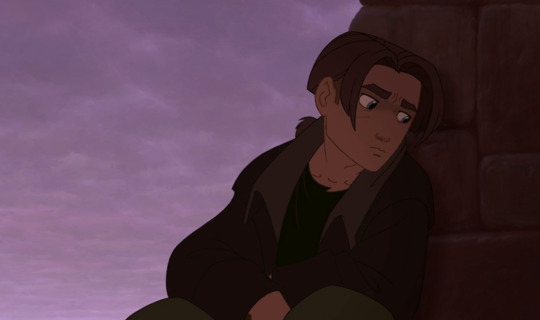
The first minor change in this shadow is the moment when Jim’s passion is ignited in something for the first time in a long time; the prospect of travelling to Treasure Planet, which Jim hopes will allow him to prove he’s worth something to his mother (a doubt that’s created by him entirely), and have a real shot at something other than resigning himself to a rebel. This spark of hope lightens the shadow for the end of that scene. This might also be a good time to mention that the shadow could be symbolic for self doubt as well. This one may be not as clear to see because of the difference in lighting, but you’ll notice if you rewatch the movie carefully.
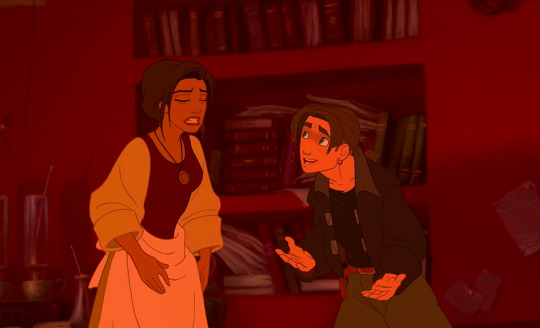
Jim then opens up a bit, starting to let go of his past hurt as he warms up to Silver, him acting as the new father figure in Jim’s life. This is shown not through the shadow, as Jim still hasn’t fully let go of his past, or fully bonded with Silver at this time, but through the change of his clothes into a much lighter, more natural tone.
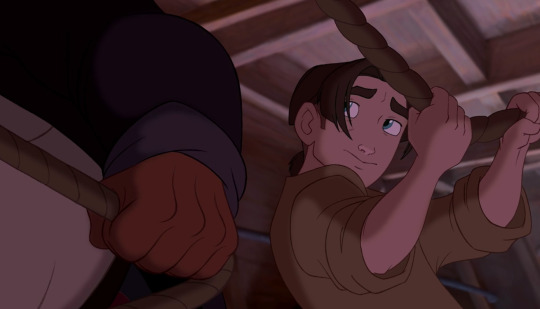
Directly following the above scene id the first time the shadow makes its’ disappearance from Jim’s face; the moment when Silver takes Jim with him on a boat ride, a parallel to the way Jim’s father left him behind. Silver, however, waits for Jim to jump in, and proceeds to bond with him by teaching him sailing (is it called sailing?).
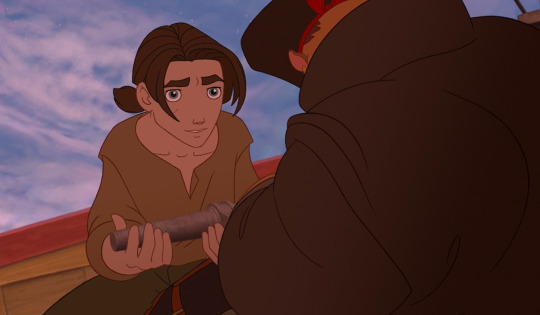
The black coat and shadow return, however, as Jim’s guilt casts it upon him at being blamed for a crew member’s death after being accused of failing to properly fasten his line. The coat here serves to act as an emotional barrier that Jim has used since the outset of the movie as he’s moved to sit alone on the edge of the ship.
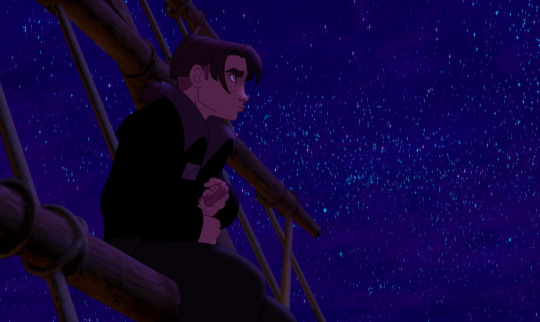
The shadow disappears later in this scene, however, as Silver encourages him, and eases his guilt. He tells Jim that he believes there is greatness in him, and hopes that one day he can “catch some of the light that’s comin’ off [Jim] that day.” the day in question being when Jim finally achieves the greatness Silver knows him to be capable of. This introduces the light and greatness motif, which continues throughout the rest of this film, showing they go hand in hand, and once Jim is able to finally step fully into the light, he’ll be able to be free of his past, and reach his full potential.
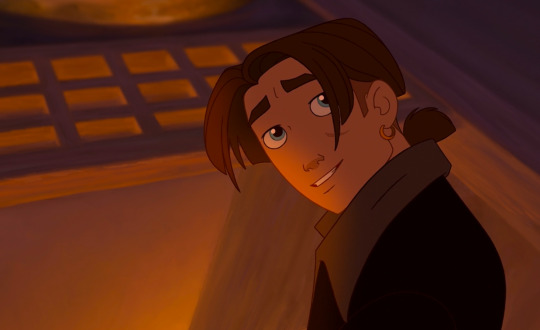
The coat remains, however, until the next morning, when, with some encouragement, he leaves it behind. This may seem just a little gag to show Jim with morph, and it could be, but it could also demonstrate that change isn't instant, depending on how deeply you want to read in to individual scenes.
The shadow comes back once again when Jim’s trust in Silver is broken, and when he’s hurt by the older man, in this scene, it’s in the form of his lamenting to his pirates that he never cared for Jim, and was merely trying to keep him off their backs. This brings back the feeling of betrayal Jim felt when his father left, as the man he cared for and trusted portrayed the fact Jim meant nothing to him. Again, brief scene, and this was the best shot I could get.
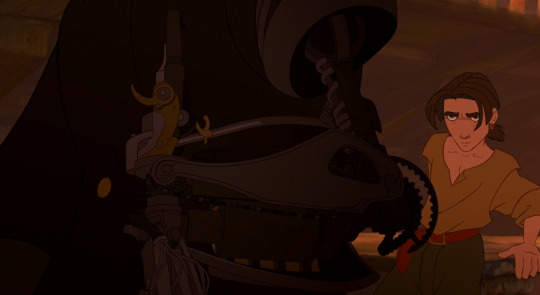
The coat notably does not make a reappearance after this scene, nor for the rest of the movie, showing that despite the hurt Jim experiences here, he has grown as a character, and is more confident in himself than he was at the start. This change remains, and is not undone, even by Silver’s selfish actions.
The shadow finally leaves a few moments later, when Jim is entrusted the map by the captain. This gives him purpose, and a goal, which allows him to move past his hurt and do what’s right, which he knows will ultimately help others. This also shows his character has grown, as he moves past his pain to take on the responsibility without hesitation.
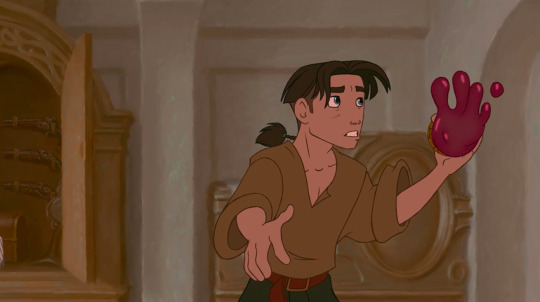
The shadow’s returns for the remainder of the film are nearly exclusively when he is reunited with Silver, or at the very least related to him in some way. All of this ties back to the light motif I mentioned earlier, as when Jim is given encouragement by his friends (captain, doctor, Ben, etc.), he is able to step up confidently, and take on responsibilities, reaching more to his full potential. This is contrasted by Silver’s presence, the man destroying that self esteem and bringing feelings from Jim’s past up despite personal growth.
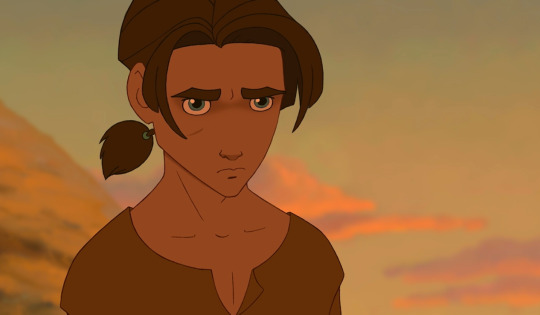
Later in the film when Jim leaves his hideout on Treasure Planet with Ben, he quite literally steps into the light to help the others (in this scene, namely to retrieve the map from the Legacy to stop Silver from reaching the treasure and harming his friends). This shows that Jim’s selfless nature will eventually be his greatest strength (and already prominently is), and will be the thing to lead him to ‘greatness’.
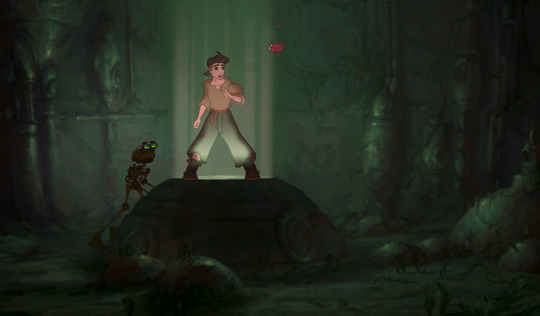
When the shadow is missing, in scenes such as this, Jim’s face also seems to be overall more relaxed; brow less furrowed as he lets go of the past, and stops the aspects of the shadow (such as self-doubt) that he had been casting himself.
Jim’s gun flying away during the fight scene on the ship is also symbolic of his growth; his freedom moving just beyond his grasp (as he’s dragged down by memories through Silver), but him finding a way to keep fighting and continue triumphing anyway (as shown through the inconsistent shadow).
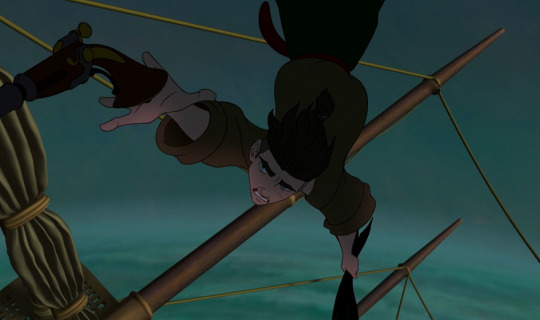
Silver’s influence on Jim (at the moment negative, as it is directly tied to the visual element of the inclusion of the shadow), is shown vividly through the scene where Silver’s pirates restrain Jim and take the map to Treasure Planet. The shadow only appears when Jim glares at Silver, but lightens when he’s focusing on doing what’s right (fighting the pirates) rather than his hurt.
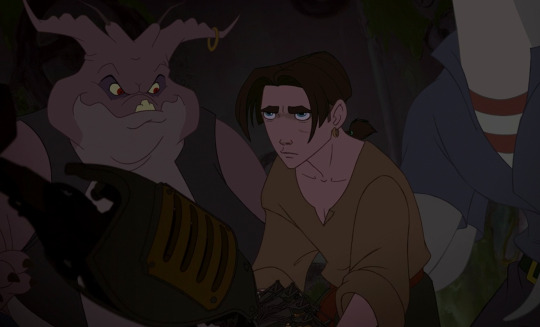
Jim assertively telling Silver that if he wants the map, he has to take him along also serves his character growth really well. He's standing firm in his own decisions, despite losing the approval of his father figure, finally becoming his own person outside of others’ expectations or notions of him, and making these decisions based on what’s right, rather than simply rebellion.
The light from the doorway to the treasure gently lightens the shadow, symbolizing Jim's belief that his pain will be dissipated by gaining the treasure, and that he will gain his mother’s pride (which was already present) as well. This is a falsehood that Silver must face as well, both accepting that the treasure was meaningless overall, and would not give them what they wanted.
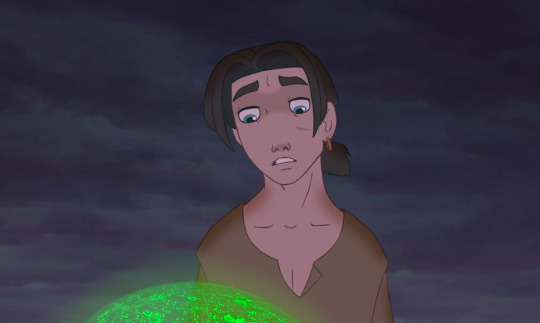
This recognition is clear to the audience well before it is to the characters, which is achieved subconsciously through the scene where, while all of the pirates are gazing towards the treasure, Jim looks back at Ben and morph, his friends meaning more than the treasure he’d searched for.

The next piece of symbolism is my personal favourite from the film; Jim falling while they are with the treasure. He works to pull himself back up, but needs that final pull from someone who cares about him (Silver). This symbolizes Jim trying to move past his father’s abandonment, and step into the person he’s grown to become. But he can't do it on his own, to fully make the leap, he needs the support of a father like figure, who in this case, is Silver, choosing Jim’s life over the treasure.
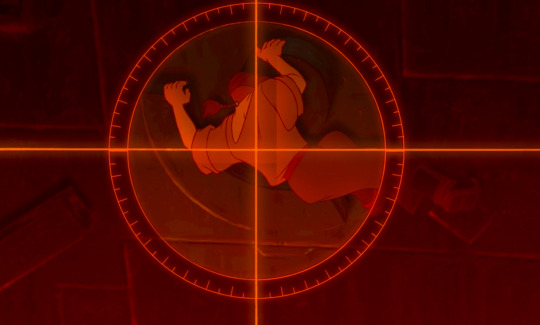
The shadow, which was likely present throughout and after this scene (there were few clear frames of his face, but let’s assume it was) darkens again at Jim’s realization that Silver may leave him, which comes when the captain comments about him being put to trial. This brings up strongly his final moments with his father; this may not seem like much now, as it is a very brief scene, but it strengthens the conclusion of his time with Silver, which we’ll get to in a minute.
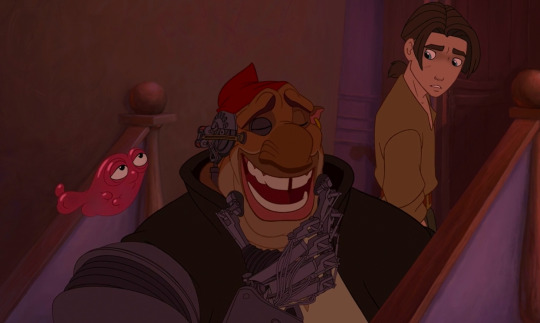
The shadow then disappears once and for all as Jim relies on his strengths, both internal (selflessness), and external (knowledge of mechanics), to build a solar surfer to allow him to save his friends and their ship from being destroyed. This shows him finally reaching that confidence in himself and his abilities that Jim has sought after his entire journey, and, as a result of this, he is not negatively influenced when he interacts with Silver in the form of the pirate helping him with the construction of the solar surfer. He has, at this point, nearly completed his arc, and moved past his insecurities.
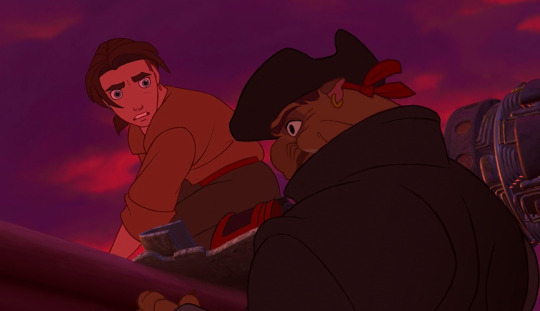
Jim then falls again, in a similar way to the previous time near the treasure, however this time, he is able to keep a level head, and manages to save himself. This symbolizes more than anything his character growth, able to rely on himself to help others. He’s finally achieved that light and greatness Silver told him was inside all along. This ability to stop his fall, and confidence as a whole, is due in no small part to Silver helping him earlier in the film. He needed someone who believed in him to push him to become the fullest version of himself, and recognize the greatness he was capable of.
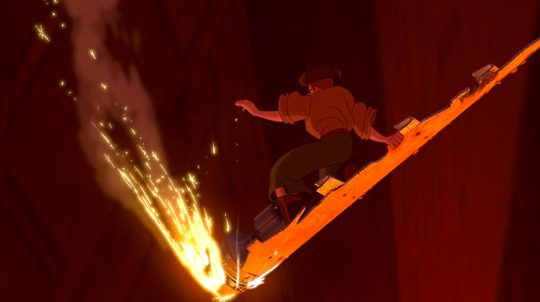
The solar surfer was introduced at the onset of the film, when we were reintroduced to Jim as a teenager. The source of rebellion at the start is now a means he uses to help others, and once he’s safely back on the ship, he lets it go. He’s no longer using it as a means of escapism; his friends now mean more than that did, and he literally lets his past go for them without regret, as his developed character no long has to rely on those methods of rebelling.
This time, when Jim sees Silver preparing to leave, he’s confident enough in himself, and the connection they shared to let him go without memories of the past tearing him down, and visually, without the shadow returning. He lets Silver go, because his self worth no longer lies on the approval of a mentor, but rather on who he is.
Silver also notably turns to wave to Jim as he sails off, for the first time making himself, and this event, entirely separate from his father in Jim’s mind, showing the contrast between the means of support in these figures.
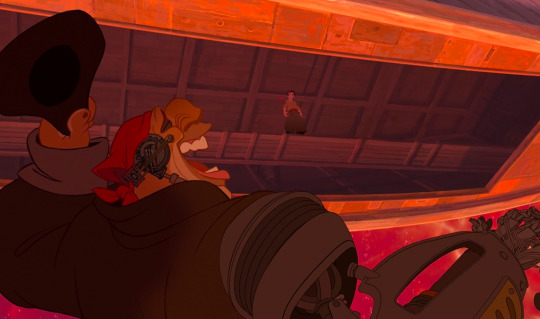
The light and greatness motif comes back in their goodbye, when Silver tells Jim he’s “glowing like a solar fire.”, showing the growth he’s seen in Jim, and, unlike the first time he said something similar to this, Jim genuinely believes him. Not just in a temporary comfort naive way; Jim believe that Silver is speaking the truth, and that confidence pushes him to take a shot at a future he never believed he could have.
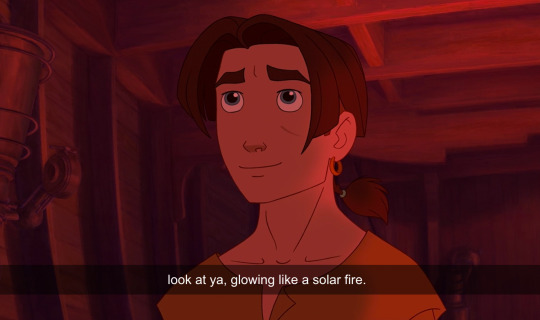
This motif makes one final appearance at the conclusion of the film, when he is shown wearing all white, yet another lighter change in his wardrobe in this film. This demonstrates his freedom from any burdens of the past as he finally accepts and learns to love who he truly is, and take daring shots to reach his potential, the one his mother had seen in him since ten beginning. His character arc is now complete, and he can live happily ever after.
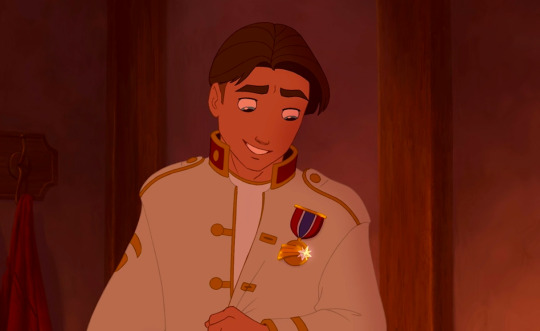
32 notes
·
View notes
Text
The Potential of Glimmer's Villain Arc
Okay so a lot of people have been theorising about what's coming next for Glimmer's character with everything that's happened in Season 3. And I have plenty of thoughts of my own so this is going to be my longest analysis post in a while. I'll put it under a cut for ease of reading, and I hope y'all enjoy!
So as an introduction let's briefly look at where Glimmer is now. She's getting ever closer to Shadow Weaver, and we all know how well that ended for her father, plus the loss of Angella is undoubtedly going to be hugely traumatic for her, especially because as she herself says she assumed that Angella would always be there since she was immortal.
Angella is gone, Adora is going to be under a whole lot of mental strain of her own due to the revelations she's had about her past and the pain of having lost both Catra and Angella for good as far as she's concerned, the rest of the Princess Alliance aren't exactly around a whole lot at Bright Moon, and it doesn't look like Shadow Weaver is going anywhere any time soon as long as there's power to be had and the Rebellion is where she can best work towards her own goals.
What I'm saying is, Glimmer likely isn't going to have much of a support system except for Bow next Season, and she's in a prime position for Shadow Weaver to employ similar manipulation tactics and methods of abuse on her as she did on Catra and Adora. Glimmer has no real experience with that type of abuse and manipulation, or any real frame of reference to understand the more nuanced form of evil that Shadow Weaver represents, and so she probably won't realise that she's being played and pushed down a darker path until it's too late.
So with that basis established let's look at some of the other signs that seem to point towards an arc of this sort for Glimmer.
One very significant thing is some of the cinematography in Moment of Truth.
First Glimmer is positioned directly in front of the image of her father in this shot, showing us that she's figuratively as well as literally taking the same position as Micah with regards to becoming Shadow Weaver's pupil. Note that she’s standing in darkness rather than in the light in this frame as well, because that’s going to be important going forward.
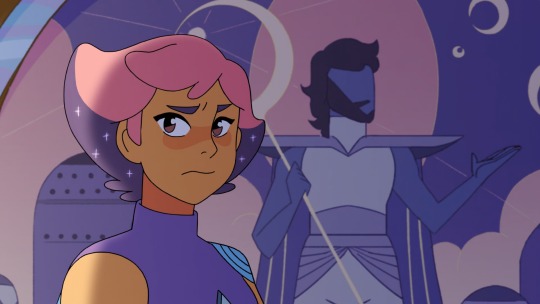
It’s also very telling that this shot comes right after Glimmer argues with her mother about the best course of action and first suggests accepting Shadow Weaver’s help. The visual symbolism of her replacing her father on screen reflects her taking the first step towards filling the same role as him in the story as well.
Then we have Glimmer flat out stepping from the light into the darkness as she decides to perform the spell with Shadow Weaver. Which is extremely Not Subtle.

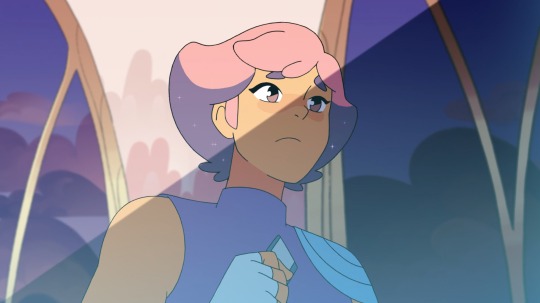
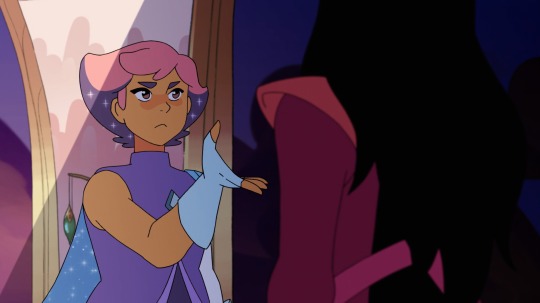
Plus the angle of the following shot making Shadow Weaver's outstretched hand look bigger and more striking to highlight the threat that the offer poses.
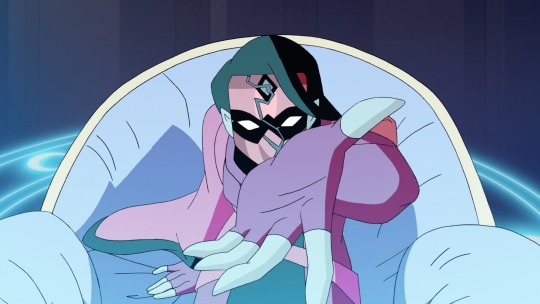
And finally there's the way that the scene where they actually do the spell is framed. Shadow Weaver's hand extends through the circle, like a barrier is being crossed metaphorically, and again it fills the screen to make it seem threatening and imposing.

Meanwhile when we get the reverse shot, which I might add is clearly meant to actually be from Shadow Weaver's perspective, Glimmer looks very small and very young, an uncertain and far less powerful figure ripe to be taken advantage of.
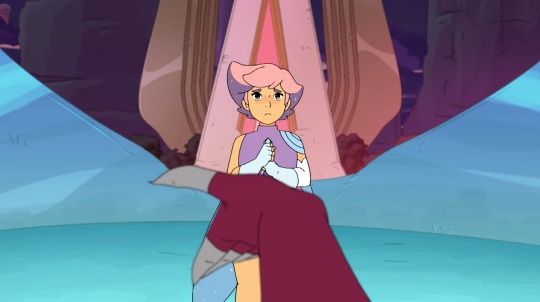
There is no way that the tone of this scene was accidental. Without any dialogue being exchanged it's telling us that Glimmer is going to suffer for this choice---it's telling us to be worried---and it's honestly a masterful piece of television.
Another aspect that isn't hugely noticeable on first watching is the undercurrent running through the show of Glimmer's desire for power. She's not obsessively power hungry the way Shadow Weaver is, that's for sure, but she does often demonstrate annoyance at her own limitations.
"Glimmer is frustrated by the constraints of her magic, by the constraints of being a princess, the daughter, of this immortal queen — her mother is this kind of immortal, untouchable angel and her father was the best sorcerer that Mystacor has ever seen. And she’s in the shadow of that." (x)
This quote from a recent interview with Noelle Stevenson pretty much spells it out, and I don't think I need to mention the importance of the use of the word "shadow" here.
With all of that covered, I want to move on to something I haven't seen talked about as much, which is the ways that Glimmer and Catra are paralleled in the story.
"In some ways I think [Glimmer]’s a little bit of a mirror to Catra, although neither of them would ever admit it."
I find this quote from the same interview incredibly intriguing, and it gives me lots of ideas about not only the potential development that a villain arc for Glimmer could bring to her own character, but also the development it could bring in terms of her and Catra as foils for each other in the narrative.
For a start, Noelle then goes on to talk about how "it’s always been this kind of like losing battle for [Glimmer]" and I would like to point out the resemblance to Catra's lines about how she "never gets to win" and "if [she] wins a battle [she] loses the war", because this really does seem to foreshadow that Glimmer could end up in a similar place next season to where Catra was at the end of Season 3.
"So when someone comes to her and offers her more power and the ability to actually really save the day and prove her worth, she takes it. Glimmer’s also sorta crossed the line in the sand this season."
This part of the interview I want to bring up just to further prove that the way these things were written this season was certainly deliberate and it isn't reaching to draw these conclusions from them. It's apparent that the writers are very aware of what they're doing in terms of Glimmer and Catra's character arcs and the possible link between the two so I simply wanted to include this quote to give my analysis here a more solid grounding.
The one thing I'd like to pick out of that as well is the idea that Glimmer is looking to "prove her worth", which is something that has been the core of Catra's decision making throughout most of the show so far. In the past it was Catra making bad choices in an attempt to get respect and admiration from Shadow Weaver, and now I believe it will be Glimmer's turn to do the same.
But beyond that, I want to wind the clock back to the beginning of Season 3 for a moment, specifically to when Glimmer asserts that "evil people don't change." Adora is quick to point out that that is an extremely reductive mindset to have and far from always the case, though she does so by applying it to completely the wrong target in the form of Shadow Weaver who is almost certainly not going to be redeemed in any way, but that got me thinking about how Glimmer flirting with her inner darkness could be utilised in the story in exceedingly interesting ways.
The most obvious path is that through having to redeem herself for bad decisions that she made for understandable reasons, Glimmer would come to realise that things aren't as black and white as people being good and evil but rather there is far more nuance to be found with regards to morality. Basically, she would gain a greater understanding of what it means to be good or bad and the possibility of redemption first hand and grow to acknowledge that she was wrong to oversimplify it down to a binary choice of people being immutably good or evil and never able to change.
However, I would also like to discuss how Glimmer's villain arc could intersect with Catra's redemption arc. Glimmer has always balked at Adora's attempts to get through to Catra, telling her that Catra is evil because she's with the Horde and dismissing the notion of a redemption for her. But if Glimmer sinks to that same point---if she hits rock bottom the way Catra did---and she sees Catra pick herself back up and rebuild herself successfully to become a better person than she was before?
Well, then that could provide some amazing inspiration for Glimmer to then follow in her footsteps and break free from the cycle of Shadow Weaver's abuse herself as well. Add Catra getting to see that the Princesses are far from perfect but fallible people just like everyone else on top of that, and both Glimmer and Catra would evolve as part of the same arc and come out of it with a much stronger understanding of each other and just how people work in general.
Lastly I want to bring up this quote that I’ve put below from a recent convention.
"Interesting foil! Catra is a secretly sweet person with her darkness on the outside. While Glimmer is the opposite."
As well as again emphasising that Glimmer and Catra are in some ways two sides of the same coin, this would definitely seem to back up my theory and indicate that Glimmer has depths that she herself doesn't even understand that are now going to be pulled to the surface by Shadow Weaver.
To add to this, in the interview I drew from earlier Noelle comments that "the way this season ends has major repercussions for Glimmer. It throws her into a world that she never expected to be in." I think the second half of that quote is key. Glimmer never realised that she had this darkness within her, let alone expected to tap into it, and this is why it could lead to serious growth for her as a person to discover the worst of herself and in the end choose to cultivate the best of herself despite that.
There’s one more layer to the Glimmer/Catra aspect of all this as well if you combine this theory with the concept of Micah being alive and mentoring Catra during her redemption process. Because it would link Glimmer and Catra even more closely and beyond that it would create a great call back to the fact that this arc started with Glimmer being paralleled with her father.
And if Catra does work with the Rebellion at some point in the distant future, this could also serve as a starting point for the two of them constructing a friendship using the foundation of that shared similar experience (and also a shared father figure potentially) as they learn how to be part of the same team. It might also play into restoring Adora's faith in the people around her as seemingly losing Glimmer to darkness so soon after losing Catra the same way would undoubtedly nearly destroy her and it would give her some much-needed motivation to see both of them pull themselves back from that.
Anyway, there we have it. Those are all of my thoughts on why I do definitely see some kind of villain arc for Glimmer, and how I think it could be an excellent addition to the show for a number of reasons. Thanks for reading and see y'all next time.
#she ra#spop#glimmer#shadow weaver#catra#adora#she ra glimmer#she ra shadow weaver#she ra catra#she ra adora#spop glimmer#spop shadow weaver#spop catra#spop adora#she ra meta#spop meta#my meta
138 notes
·
View notes
Text
NCIS post-ep ramble 17x01
I know it’s been days since the season 17 premiere and I had every intention of writing something earlier but just didn’t have time (plus I have been so caught up in reading everyone’s thoughts and reblogging all these posts and general flailing that honestly, who has the time for anything??) but I most certainly do have a few thoughts and feelings about the ep I’d like to get down.
For those who don’t know me that well, hi :) and also, I’ve always been rather partial to a post-ep ramble (which is basically me trying to process everything by dumping many words here) so I thought I’d throw a few words down because let’s be real, ‘Out of the Darkness’ was A LOT.
Ok, so can we talk about the opening scene, because it seemed like a classic NCIS ‘guys doing a dodgy deal but wait, the team needs the vehicle’ kinda moment but then FINGERS. Actual freaking fingers on that car dash and I should mention I was live streaming this episode on the train on my way to work and I was NOT chill at this point because it was brutal.
I was having so many feelings right from the get go, I mean Ziva is back and even through we’ve had months to process this it still felt so surreal yet like she’d not really been gone for that long, except that from the very first interaction with Gibbs in the basement, you could just see that she’s different. It’s subtle but it’s there. I love that the moment Gibbs’ basement starts getting shot up and both he and Ziva are out of ammo, they immediately default to working together to create the makeshift explosive thing, no words, just right into the groove of knowing what needs to happen without treading on one another’s toes.
Meanwhile Nick, McGee and Ellie are obliviously having a drink (lol @ McGee lasting less than two seconds not talking about work), for anyone into the Nick/Ellie ship there was a nice little moment and the three of them hot foot it to Gibbs’ place after after McGee gets the call to say there’s been a shoot out (seriously, can you imagine being Gibbs’ neighbours? The weird-ass stuff that has gone down there over the years, that’d be one house you’d tell the kids to skip for trick or treating). I am so into the follow through from the Ziva set up last season, Ellie feeling like the fabric was familiar was a nice way to bring it all together.
It’s funny, after so many years of watching this show then stepping away for a little while, I’m really not sure what I expected when I heard that Ziva was going to return. My shipper heart is really just locked on to Ziva and Tony finally getting some kind of happiness, but I was unsure what it would be like seeing this character on screen after so long, especially considering the way she was written out initially. Can I just say that the way Ziva has returned to our screen exceeded any expectations I did or did not have. I never in a million years expected this show to not just consider, but actively highlight the toll of all the years of trauma and struggle of Ziva David. A credit to the direction in this scene, but as Ziva began having the anxiety attack in the sewer pipe and we gained our first glimpse of her battle with this demon, it was unnerving to see this character who had always remained so seemingly in control, so vulnerable. But it was also wonderful (and heart-wrenching and sad). I am so grateful to Gina Lucita Monreal (who I Stan v. hard btw) for showing this side to this character because to me, it demonstrates not only the character’s journey, but NCIS’s growth.
Gibbs knowing that Ziva needed space and giving it to her but then finding her in a state that clearly caught him off guard was once again something I was not expecting and I was floored, yet again, when the pills Ziva stuffed back into her pocket were actually addressed and spoken about on the bus (I realise it sounds like I’m just constantly surprised but in the past, it’s the kind of thing that may get followed up about six episodes down the track, though I’m aware there isn’t the luxury of drawn out breadcrumbs with this arc and honestly, I’m grateful).
The scene between Ziva and Gibbs on the bus is quite possibly my favourite interaction between these two characters ever. And yes, I mean in the entire series. Hearing Ziva talk about Tali, explain the significance of the necklace and then put it to Gibbs that wouldn’t he do anything if it meant he could hold his daughter one more time, ugh my heart. The ONLY thing I disliked about this episode was later when Ziva said she wasn’t talking about Kelly. I understand the sentiment and I am here for her calling Gibbs out on giving up on her every day of the week, but in that moment on the bus, it absolutely was and should have been Kelly she was referring to because it was in that moment that she and Gibbs connected on an entirely different level - as parents. And more than that, as parents who know what it’s like to risk everything because of the love they hold for a child. So while I do love that Ziva put it to Gibbs that he abandoned her, I do feel it could have been brought up in a way that didn’t diminish the power of that conversation on the bus. Because when Gibbs reached out and touched that scar on her wrist, it may have been a small gesture but the meaning was huge and yes I did start crying and no, I did not care that I was on a train.
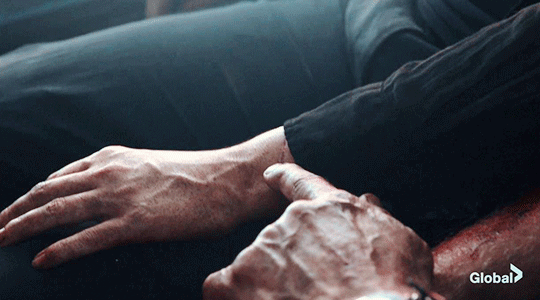
Of course we must talk about Odette. Sweet, old, possibly an assassin or some other kind of highly trained deadly human Odette. When Bishop asked her, ‘who are you, really?’, all I could think was, same girl, same. I am so into this character and I really hope she sticks around because her turning up later in the ep with a car load of weapons and then wanting to join in just upped my curiosity even more.
I really am such a fan of Ellie, I have been since the beginning, and I did feel for her trying to balance the wishes of Ziva and her loyalty to her team. McGee’s reaction to finding out that Ziva was alive and that Ellie knew about it was definitely warranted and my Tiva loving heart is trying very hard not to read too much into everyone’s avoidance of answering whether Tony knows (read: I am 150% reading too much into it and of course he knows because Ziva has obviously been leaving clues the entire time that she’s ok and it’s fine, it’s all fine, I’M FINEEE*)
*I am not fine
Nick is immediately suspicious after the awkward af conversation in Vance’s office where every time he mentions something from the crime scene at Gibbs’, Ellie and McGee very obviously downplay or dismiss it. Plus Ellie’s sweaty neck is apparently a dead giveaway and I love that Kaisie also mentions it because when this show does funny, it does it damn well. Aside from the bus scene, my other favourite scene of this episode was in autopsy when Nick ‘I don’t even know this ninja but this is like the biggest news of my life’ Torres has just learned about Ziva and Jimmy ’you said the thing about Ziva and my ears heard it and now I think I need to sit down’ Palmer also gets clued in and honestly, this entire sequence is absolute gold. I heart Kasie so hard and her discomfort with the ‘weird air’ just lent itself to making the whole thing wonderfully hilarious and the dynamic between all the characters was so on point. Nick and Kaisie really are stellar additions to the show, it just works.
Ziva’s determination to go it alone definitely wavers momentarily after Gibbs has spoken to McGee and asked him to decode the encrypted SD card (so many lols at Gibbs asking Ziva if she wants to talk to McGee then telling him she says hi. Again, the writing in this ep is just brilliant, being able to slot in genuinely light and funny moments between the dark and serious), there’s the ever-so-brief expression before Ziva gets into the car, as though she remembers what it’s like to have a team, her team, working with her.
What is on the card of course leads Gibbs and Ziva to be standing in the man who uses phrases like ‘dope’ in front of his machete wall’s office and I have to say, his ‘what are these two homeless people doing in my office’ was accurate. The show then stabbed me in the heart with the necklace situation - either her heart or her albatross- and of course it all connects back to Ari (the parallel to Saleem ripping off her necklace was noted). We also get our answer as to why Ziva had those severed fingers in the opening scene which is still gross and brutal but also understandable and much better knowing that the dude was dead when it happened. But still gross.
One thing that really struck me was when McGee, Ellie and Nick see Gibbs and Ziva making their getaway and McGee and Ziva share their moment of locking eyes and her indicating for the team to stay put, it is Ellie who points out that, ‘she knows what she needs better than anyone else’. It was just really interesting to me that McGee’s initial instinct was to go after Ziva and Gibbs, despite Ziva clearly not wanting him to, and it is the woman on the team who points out that he needs to respect Ziva’s wishes and trust her. I have no idea if this was making some kind of larger statement but it felt significant to me for some reason. Plus I just love the respect Ellie has for this woman she has never met and I can’t even imagine what it must have been like for her to see Ziva in the flesh for the first time after harbouring her secret for so long.
We all knew Vance would find out eventually and omg Nick just cracked me up, ‘I’m the least guilty one in here, Bishop is the worst...’, he is just such a great character (in case I haven’t mentioned that enough times). I don’t know enough about Sloane at this stage and I’m a little confused about her role or position so I will catch myself up on that (or feel free to fill me in) but she also seems pretty cool. I think back to early days McGee, the nervous probie who was so unsure and then think of him in this episode, standing in Vance’s office defying orders and all I can hear is Tony’s voice saying, ‘I’m proud of you Tim’. I love that he’s backing Ellie and that he’s standing up for and trusting her and knowing Vance’s history with Ziva, it’s just all such a wonderful coming together of NCIS history and the present.
The final scene of course left us in a TBC moment as Gibbs’ attempt to arrest Sahar (or at least a woman I assume is Sahar but then it’s NCIS so who knows?) is railroaded by Ziva’s adamance that unless she is dead, Sahar will always be a threat. I can’t wait to see how it all unfolds, I’m just loving the speculations and excitement and most importantly, consideration with which the show seems to be bringing back these storylines and characters and really, I do believe we are in for quite a ride and if this episode is anything to go by, one heck of a payoff.
#NCIS#ziva david#leroy jethro gibbs#ellie bishop#tim mcgee#nick torres#leon vance#tiva#ramble#thoughts#feelings#so many words
79 notes
·
View notes
Text
On Romanogers and Steve and Natasha’s endings in Endgame:
******SPOILERS BELOW******
I enjoyed Endgame as a whole. But all in all, I’m disappointed.
Romanogers: Going into Endgame, I really was not expecting much. After all, Steve and Natasha didn’t even exchange any lines in IW. As much as I could hope and dream about my two favorite characters and my #1 OTP getting together in the end, I knew it wasn’t happening and was/am fine with that. Their interactions in the beginning of the movie definitely make the closeness of their friendship highly palpable. Even if they were not speaking to each other, they were always standing or sitting next to each other in the same frame. I’m really glad that we got another trademark deep Steve and Natasha talk. What I’m not so glad about is the closure that this complex friendship got. When they get their missions to retrieve the stones, they all think they’re going to make it back, I know. Even then, ceasing all interactions between Steve and Natasha with one little “See you in a minute” from her does not cut it. They grow so close over the span of, at this point in the movie, over ten years. The depth of their relationship has been explored so many times throughout the movies from the “I would now” scene in CA:TWS, to the “I didn’t want you to be alone” scene in CA:CW, to them going on the run together between CA:CW and IW. They became each other’s rocks, gaining shared life experience, and yet, we only see Steve shedding one tear for her and hardly talking about her within the span of maybe a two minute scene following her death so devoid of emotion (from all parties), let alone the rest of the movie. Clint and Natasha got their closure. Tony’s character got his closure with everyone he loved in a long scene with a poignant voice-over. With the movie barely making time for an emotional goodbye for the ending of this deep friendship that spanned over a decade, it is not what the characters who have grown so much in each other’s company and in their shared experiences deserve.
Natasha’s ending: In a logical and pragmatic sense, I understand why Nat is the one to make the sacrifice. She felt that it was her duty to “wipe out the red in her ledger” and make up for her past, though Clint felt the same way for what he did as Ronin. While she did view the Avengers as her family, Clint has a wife and children. This factor, one could argue, makes Nat the more expendable of the two. So yes, it makes sense that she was the one to go. What came after does not sit well with me. After Clint comes back alone, only a very brief grieving scene is shown for a woman who willingly gave up her life for the sake of her friends and the world, which barely even allows time for audiences to soak it in as well. There's no time for funerals in war; I understand that. Yet, when peace finally came, there was still hardly a mention of her. Furthermore, as part of the O6, her character deserved to be at the final battle. She deserved to be right there when Steve finally says “Avengers assemble” on screen and during the team-up of all the female heroes. She only got 33 minutes of screen time, while her other core teammates, Steve and Tony, whose character arcs also end in this movie, got over an hour. I’ve seen arguments that say the movie didn’t give her a formal or long goodbye because they might try to bring her back or that she’ll get more time in her own upcoming movie, but still. Nat’s character has never been explored in depth in her own solo movies prior to Endgame, nor has it been a main focus of any other movies. The pacing of her death in the movie warrants such disrespect toward her character, a character who always supported her team, a character who wanted her team to stay together no matter what, a character who has made great waves in pop culture. Though her death makes sense for the flow of the movie, there was definitely not ample time granted toward her exit.
Steve’s ending: [Note: I am not trying to hate on St*ggy in any way. I love that ship. That scene at the end actually made me cry. I’ll just be talking about how this ending just doesn’t make sense.] There’s two theories that I will be addressing here, so please bear with me and my potential lack of knowledge about Endgame’s time travel rules. 1)Steve goes back in time within the same main MCU timeline. My initial understanding was that this was what occurred because putting back the stones restores the main timeline, but then you have all the questions of how does this not significantly alter history, the the whole franchise’s stories, etc, which leads me to the other theory I came across. 2)Steve goes back in time and his staying in the 40s and living out his days with Peggy creates an branch timeline that runs as a close parallel to the main MCU timeline, with the branch timeline ultimately converging with the main one when we see Steve as an old man at the end of the movie.
Now this is the confusing part. With both theories, even for the second as it supposedly runs as a close parallel, historically would not make sense. So Steve goes back in time, marries Peggy (for all my Romanogers shippers, I know there’s hope out there that he married Nat somehow since he never said who he married but this is a whole other interpretation I won’t be diving into in this post) without altering the main timeline of the first theory??? And even if it was the closely running branch timeline of the second theory then doesn’t that mean his staying in the 40s significantly veers that timeline away from the main one then???
Time travel workings aside (this hurts my brain), Steve’s decision to stay in the past is insanely out of character. It is a contradiction to his arc that Markus and McFeely (screenplay writers of all the Cap movies, T:TDW, and IW) have built ever since CA:TFA. Many of the movies have focused on Steve attempting to adapt to a foreign modern world. They touch upon his struggle to move on from his past and his eventual acceptance of his situation. And that was his character growth through the years–a man out of time eventually finding friends, family, and most of all a home in the Avengers.
His action, I believe, goes against his morals. By staying in the past with Peggy in either timeline, he knows he is erasing her relationship with her husband and the existence of her children, who may have affected history in a sizable manner for all we know. And I don’t think Steve is one who can sit idly by throughout the course of history without taking action (this relates more to the first theory, but if the second theory states it is a close branch to the main timeline, then not much should change either right?) and truly living a quiet life when he knows that suffering, pain, political unrest, and oppression will occur. This implies that he is going to live through the Cold War, the Vietnam War, the whole Civil Rights Movement, and much more and not contribute anything significant to the alteration of history. Simply the thought of him not telling Peggy about HYDRA already being in SHIELD is hard to grapple with, along with how much he could have changed the development of SHIELD. And then there’s also all of Bucky’s missions and assassinations though the years. Don’t even get me started on 2011 onward when they find and unfreeze an alternate Steve. There’s so many unanswered questions, and my thoughts probably only scratch the surface of the logistics.
I get it. Steve deserves a happy ending and a restful life. They all do. The end scene was beautiful and poetic with “It’s Been a Long, Long, Time” and the long-overdue dance and the ever-cliche kiss. Yet this end scene felt somewhat too dreamlike, bordering on fan fiction-like. I have such a love-hate opinion of this scene. I mean, I guess I would say that this reveals the biases of Markus and McFeely for St*ggy and how they believed Steve and Peggy were always the only ones meant for each other. However, I think that it is truly a regression for Steve’s character development as Peggy was the one who urged him to move on with his life as she had lived a full one herself. They demonstrated in previous movies that Steve was finished clinging so tightly to the past, yet they make a 180 and go straight back to his mentality from 10+ years ago.
I, personally, cannot think of another decently satisfying end for Steve that isn’t just him dying, so I have no suggestions. While the ending was sweet, it just doesn’t make sense.
#romanogers#steve x natasha#captasha#capwidow#steve rogers#natasha romanoff#captain america#black widow#avengers: endgame#endgame#endgame spoilers#anti endgame#endgame wank#?#stevenat
72 notes
·
View notes
Text
Alchemists and Paladins
This analysis is derived from @leakinghate‘s Seek Truth in Darkness post that breaks down the "errors” and discrepancies in Season 8 that point to the version we got in December being cut up and frankensteined back together in post-production.
One of my big disappointments is that we never got on-screen acknowledgement of Shiro’s connection to the Black Lion following Season 6 despite the fact that he was still wearing the Black Paladin colors. While re-reading Leaking Hate’s meta, a few ideas occurred to me that helped me formulate a theory about Black Paladin!Shiro in Season 8.
Despite Shiro moving on from being the Black Paladin to being captain of the Atlas, the show persistently keeps everyone in their original uniform colors. While it could just be down to staying true to the original 80s show, the visual adherence to the Season 1 configuration is a pattern that persists all the way into at least Season 7, and a few times in Season 8. There are multiple times where the team is arranged according to the lion configuration, but Lance is still in the left leg spot that Allura, as Blue Paladin, should be in, even though he’s now flying the red lion (ex: the astral plane in S5E3). The same is also done for the red lion itself (ex: the roar during Shiro’s rebirth in S6E7) a few times in at least Season 6 and 7. Even in Season 8 itself we still see characters positioned according to the season 1 configuration:
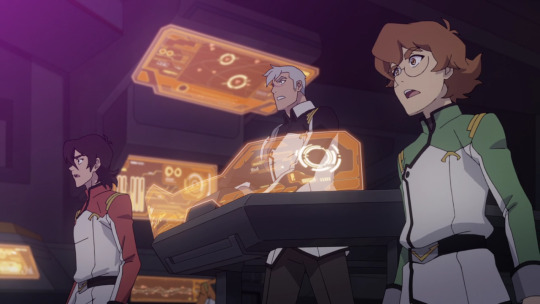
Keith is on Shiro’s right side and Pidge is on his left, exactly like the Paladin configuration in Seasons 1-2.
The marketing also emphasizes the original team lineup:
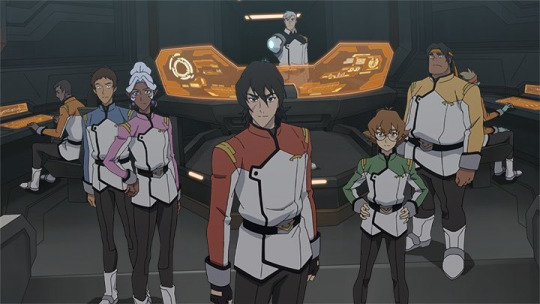
In one of the two promo images released at NYCC, the team arrangement from left to right is Lance, Allura, Keith, Shiro, Pidge, Hunk. The incorrect order for the current pilot configuration, but still in the right order for the Season 1 configuration.
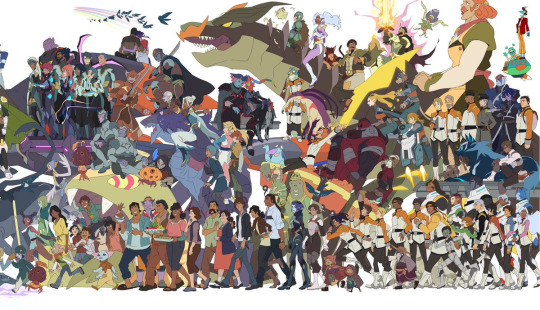
The big NYCC poster shows the team, from left to right, as Hunk, Pidge, Shiro, Keith, Lance, Allura. Left leg, left arm, head, right arm, right leg. The correct order for both the Season 1-2 configuration, and the 80s configuration.
And in terms of the textual narrative, even in their new positions post-Season 3, Keith, Shiro, and Lance thrive in their new positions by relying on the textual attributes of their previous ones. Shiro’s battlefield promotion to captain of the Atlas comes from him acting a textbook black paladin: a born leader, in control, “someone whose men will follow without hesitation.”
All of this indicated that we should have seen a return to the S1-2 configuration at least once in Season 8, but in the edited version we got in December at least, that never happened.
But if it was meant to happen in the original cut of Season 8, there is logistically only one place for this to happen: The Storming the Pyramid Sequence, as #TeamPurpleLion calls it.
Leaking Hate has laid out a detailed, episode by episode breakdown of all the evidence of cuts and editing in the version of Season 8 released in December, and extrapolates a likely outline of what was supposed to happen based on what was edited, the story structure of the series overall, and the plot points introduced in the first half of the season that were subsequently left hanging.
Multiple plot points indicate that Lotor was still alive inside Sincline and was supposed to be rescued before the final battle:
Despite it ceasing to be relevant after Honerva’s flashback episode, there are two shots in “Genesis” depicting first the Atlas and then Coalition ships flying towards the Altean Colony planet. No one comments on this unexplained detour.
The other Alteans serving Honerva besides the ones who were held aboard the Atlas in the second half, Merla, and the other two Robeast pilots, are nowhere to be seen when Coran and Slav board the pyramid in “The Zenith”. Honerva’s comments about how only the two other Robeast pilots remained loyal indicate they all defected en masse, but we are not shown this.
When the Atlas arrives in Altea’s solar system, the first interior shots of the Atlas bridge have pink lighting accompanied by Lotor’s theme music, while the rest of the scenes in this section of “Uncharted Regions” have golden lighting.
“Uncharted Regions” opens with Honerva declaring that the Paladins know her plans is an advantage, echoing her son’s words before he tricks Voltron into retrieving the Sincline comet in S3E4, indicating that she intends to trick them into helping her. Her next appearance shows her in her new mech scanning for her perfect reality. She is then shown inside the pyramid saying that Allura is awake. There is no explanation for how she got back to the pyramid and changed back into her Altean garb despite the battle happening outside, nor do we learn why Allura is even necessary for her plans. The call back indicates that Honerva needs to accomplish something with Altean Alchemy that Allura can do that she cannot.
There are at least two split-screen shots that are so heavily cropped to the point that Allura, Lance, and/or Hunk’s faces get cut off at the edge of the screen. If there were no other characters who needed to be removed, the shot would have been planned so that those cut-offs never happened.
There’s a total of 11 shots in the last three episodes where a character is off model, and their proportions are always wrong for a human but just right for a supposedly-dead-Lotor. (Things that give it away include broad shoulders, the character’s head being too small for the size the body is drawn, elongated arms, legs twice the length of the upper body, and in some shots, fangs.)
Lotor has no shadow when he appears alongside the deceased original paladins in the final episode, and his image is simply a stock photo from the official website with the leg slightly warped to hide the lack of shadow.
Lotor being healed and rescued neatly explains why Honerva needed Allura and considered the Paladins knowing her plans to be an advantage (because she cheated the trials of Oriande, she doesn’t have the power to heal Lotor herself, but Allura does, as demonstrated with the dead forest in “Launch Date”), where the remaining Alteans vanished to (they abandon Honerva after Lotor rejects her), and why the Atlas apparently makes a detour to the Colony (the Alteans need to be dropped off somewhere safe before Lotor, Voltorn, and the Atlas can go back to face Honerva for the final battle).
But there are two things that still got me thinking about this outline:
With how powerful the Altean robeasts are shown in S7 and S8, it raises the question of how Allura was able to get from the Atlas to the pyramid without being spotted by Merla or the two other robeast pilots. Even if the Atlas was keeping them occupied, “Lion’s Pride Part 2” and “Genesis” have shown how much of a challenge it is for the Atlas and Voltron to defeat even a single Altean robeast, let alone multiple. So, somebody needs to form Voltron and keep the Robeasts busy so that Allura can storm the pyramid for her alchemist vs. alchemist rematch with Honerva in the first place.
As Leaking Hate mentions in their meta, many of the shots with a character having Lotor’s proportions are in paladin armor. Given the damage shown to Lotor’s uniform, in order for him to have something to wear in the final battle, it’s implied that he’s wearing what used to be the Black Paladin armor that Shiro wore during the first half of Season 7.
My argument is that if the visual adherence to the color scheme of the lions the team started out in was supposed to go anywhere, the only logical place for it to occur is during the sequence where they assault the pyramid and rescue Lotor:
Lance could volunteer to fly Blue so Allura can go rescue Lotor, Keith steps back into Red so Lance can fly blue, and Shiro steps back into the Black Lion to lead the team one more time.
Leaking Hate’s meta pointed out how the Beta-Four-Ex-Seven coordinates have pink lighting in the backdrop, fitting with Allura’s color scheme as well.
Since this is indicated to be the site of the big Alchemist vs. Alchemist rematch between Honerva and Allura, it would beautifully parallel their previous fight at the end of season 2: Voltron fighting a mecha created by Honerva (Zarkon’s armor, the Robeasts) while Allura faces the witch directly.
If Shiro wore the Black Paladin armor into battle one last time, then handed it off to Lotor for the final battle against Honerva, it would make a nice call back to when he gave Lotor the Black Bayard to use against Zarkon in “Blood Duel”.
It would also, in a way, be a nice callback to his line in S6E3 “I don’t know what’s more fulfilling than being a paladin” by showing that while he has found things that are just as fulfilling, he is still just as much a paladin as the others.
In “Tailing a Comet” back in Season 3, Lance expresses thet Blue would take him back in a second if he asked, but he doesn’t want to stand in the way of Allura’s growth. If he pilots the Blue Lion while she fights Honerva, Lance would be stepping back into the role of Blue Paladin so that Allura can continue her growth and do something that only she can do.
While this part is hazier, an additional parallel that occurred to me would be if Allura was accompanied by a pair of Galra each time she confronted Honerva: in Season 2, she was accompanied by Kolivan and Antok. Considering their absence from the plot after Genesis, perhaps Acxa and Zethrid would have accompanied Allura to face Honerva in Season 8?
While I can understand why some people thought the ship had potential, there was one detail I kept seeing everyone ignore that convinced me that Lance and Allura would never have worked out as a long-term relationship no matter what happened with Lotor. Leaving aside the fact that Allura doesn’t appear to be as interested in the relationship as Lance is, Alteans have already been established to have a life span measured in centuries. Coran himself is over six hundred years old, and Allura’s probably at least a century or two herself. Short of pulling some species-changing magic out of thin air to make Lance actually Altean and not just give him the markings, Allura is going to outlive Lance by several lifetimes regardless of their relationship status.
Throughout the season we got in December, Lance questions Allura’s choices. Hate’s meta outlines how Lance’s arc was meant to lead to him supporting her decisions. In addition to supporting Allura verbally when she argues for the rescue mission, he would be supporting her physically by offering to take her place in the Blue Lion for that battle, because while they are both Blue Paladins (just as Shiro and Kieth are The Black Paladins), rescuing and healing Lotor is something that only she can do.
It would also be an excellent reversal of an earlier point in the season: in Clear Day, Lance signing his name on all the Blue Lion plushies even though the current Blue Paladin is Allura feels like him selfishly trying to claim Allura as his own, while for the rescue mission, he physically “reclaims” the Blue Lion out of selflessness to both literally and symbolically let her go.
This is part educated guess and part wishful thinking on my part because I’m still salty that the visual adherence to the Season 1 configuration never went anywhere. There is no guarantee that any of this happened in the original cut of Season 8. But if the visual emphasis on the season 1 pilot configuration long after we’ve switched over to the one from the 80s was supposed to have any payoff, there is only one place in the original cut of Season 8 where it could realistically work.
If you want to see what the original cut of the season looked like, then I highly recommend you sign the petition and and start writing letters to WEP.
#free vld s8#freevlds8#voltron season 8#voltron meta#voltron legendary defender#fan campaign#educated guess
22 notes
·
View notes
Text
My favourite Charmed episodes - season 1
Since Charmed is my favourite show and basically owns my heart I wanted to create a little mini meta series to it where I write about my favourite episodes from each season. It’ll be divided into eight parts (one for each season) and will reflect on why these episodes are my favourites and so special to me. As I post each season, I’ll try to include links to all the other posts for the series, but I’ll also tag them all under favecharmedeps, so you can find them all in one place.
Season 1 overall is a decent first season to the series. It doesn’t stand out to me as being the best season (in my ranking of my favourite seasons, it takes fourth or fifth position) and is definitely stronger in its second half, but it has some great episodes, very consistent character development for the sisters and the added bonus for me that it’s the only season that has Andy Trudeu, who I adore. I’ve chosen 5 episodes from the season as being my favourites - From Fear to Eternity, Is There a Woogy in the House?, Which Prue is it Anyway?,That 70s Episode and The Power of Two - so let’s dive right into it.
From Fear to Eternity (1x13)
This episode is generally a fan favourite and for good reason. It’s the first episode we’re introduced to Barbas aka. The Demon of Fear, who is arguably one of the most terrifying demons from the entire series (he’s also a fan favourite). It’s also a great episode for character development and strengthening the bonds of sisterhood, which is why I love it so much.
Prue undoubtedly has the most significant character growth, since this is really the first episode that delves into her lingering trauma of Patty’s death which manifests itself in a fear of water and her inability to say ‘I love you’. Since Prue is my favourite character, it’s so important me to see the journey Prue goes on in this episode. Not only does she manage to overcome her greatest fear - drowning - in doing so, she defeats one of the most powerful demons in existence, comes face to face with her trauma, conquers it and is finally able to tell Piper and Phoebe she loves them for the first time (x).
Phoebe has an important arc in this episode since she gets a new job and is faced with a genuine dilemma - whether to prioritise her morals or her need for a job. It’s an important lesson for Phoebe, who at this point is still young and perhaps a little naive and inexperienced in the world of work. In the end, she of course, stands by her morals and leaves the job. The most important aspect of Phoebe’s arc in this episode is her greatest fear - losing a sister. Much like Prue’s fear of drowning and inability to say ‘I love you’, Phoebe’s fear of losing a sister (although it’s not explicitly confirmed) undoubtedly comes from the fact that she lost most of her family at such a young age - Patty died when she was 2, Victor abandoned her when she was a young girl and Penny died when she was only a young adult. Prue and Piper are the only family Phoebe has, they’re her entire world and although losing a loved one is a common fear for most of us, losing one of them was definitely more significant for her due to the circumstances of her family. Scene with Prue, having lost her accidentally foreshadows Prue’s death where Phoebe actually handled losing her quite well.
Piper has a more minor role in this episode in comparison to Prue and Phoebe, but she still learns an important lesson about her attitude. Naturally, Piper is a pessimistic and anxious person (also, becoming a witch amplifies that in season 1), and her fixation on superstitions in this episode demonstrates this. She’s worried about supernatural forces that she can’t control so conforms to these little ritualistic actions in order to protect herself and the ones she loves. I’m currently doing a module at uni about myth and religion, and I’ve looked a lot at the meaning of ritual, so this is particularly relevant to me right now. But despite the fact that Piper doesn’t come face to face with Barbas so we don’t get to literally see her greatest fear, Piper shows fear in this episode as much as Prue and Phoebe, just on a subtler level. In my opinion, at this point, Piper’s greatest fear was the supernatural world and her inability to control it. From the second she discovered she was a witch, Piper was always the one that expressed her anxieties about it and worried about what it meant for her and her sisters. Piper’s experience in this episode, and her encounter with Josh in this episode, enabled her to come to the realisation that spending her life taking actions to prevent something that may or may not happen was a waste of her time and only going to negatively impact her. So although it’s not quite as clear, I believe Piper went on her own mini journey in this episode.
In terms of the sisterhood, Prue finally being able to tell Piper and Phoebe she loved them enabled their to be a new level of openness between the sisters. Phoebe’s fear of losing a sister and nearly losing Prue reinforced their bond, which was particularly important since their sister relationship was the one that needed the most development based on their estrangement at the beginning of the season. Also, even though Prue survived in this instance and Phoebe’s worst fear wasn’t realised, the possibility of losing Prue foreshadowed her death at the end of season 3. What’s significant about this is that Phoebe expresses that she doesn’t know what she’d do if she ever lost Prue, but when he greatest fear came true and Prue died, Phoebe was ultimately able to go on without Prue. Although I don’t think this was intentional foreshadowing (since there were no plans to kill Prue in season 1), they make for interesting parallels regarding Phoebe and her relationship with Prue.
Is There a Woogy in the House? (1x15)
I love this episode because it’s a great exploration of Phoebe’s character and the theme of good vs. evil, which I’m a sucker for in any show (or film). It’s the first time one of the sisters comes up against turning evil which is recurring theme throughout the rest of the series. Although Piper was turned into a Wendigo a few episodes before, it wasn’t exactly the same as what happened to Phoebe whereby she was targeted by the Woogyman because she had darker tendencies than Prue and Piper and was ultimately seduced by the evil. She even admitted afterwards that she enjoyed the power. What makes this episode so great is that it taps into Phoebe’s insecurities that she’s not as good as her sisters and she is seduced by evil but overcomes it to save Prue and Piper. It’s fantastic character development for Phoebe but also a good lesson for the sisters, who learn that in reality there is no clear cut definition of good or evil - human beings are capable of going either way, it is their choices and the actions they take to enforce those decisions that establish whether someone is good or bad.
Which Prue is it Anyway? (1x16)
I should probably mention here (if it’s not already obvious), that any Prue-centric episode tends to be one of my favourites and this episode is no exception. From the opening scenes, I adore this episode because it has one of my favourite sister moments (x), but mostly I love it because we not only get one, but three Prue’s!
On a basic level, I enjoy this episode because of the interactions between the Prue’s which are pretty damn funny - “Phoebe, I’ll call you back, I have to go yell at myself” is a classic - but mostly because of the insight we gain into Prue’s character in this episode and the great development she has. The three Prue’s were the literal representation of the three levels of conciousness/personality as proposed by Freud - the id, ego and superego - with the real Prue being the ego, blue!Prue the id and pink!Prue the superego (we see this again in Just Harried with astral!Prue). Since on the surface Prue (particularly in season 1) may have come across to some as boring, judgemental, responsible and emotionally closed off (btw, I feel strongly that anyone that thinks this is wrong, but that’s because I will defend Prue to the ends of the earth), this episode shatters that perception by showing that Prue had many sides to her personality, just like we all do, but that due to the circumstances and realities of her life, those sides to her don’t always get to come out. Blue!Prue (much like astral!Prue in season 3) shows that Prue has a wild, fun and free-spirited nature which she has been forced to suppress (like most of us are) in order to get by in the real world. But the point is that perhaps Prue has taken it too far and her ego (real self) is closer to the superego than it should be, which is demonstrated in the scene between Prue and pink!Prue at Bucklands where she questions Prue checking in with Piper and Phoebe saying that she does that a lot. This is an insinuation that being the overprotective big sister and taking on a motherly role within the family has led Prue to lose the balance between her superego and id, tipping the scales towards the superego and completely suppressing the id (which is why pink!Prue seems much closer to Prue than blue!Prue does, who Piper even points out is nothing like the real Prue).
Whilst the Prue’s provide interesting questions and food for thought about Prue psychologically, the clones were important in providing Prue with clarity about an important aspect of her personality - her pride/arrogance. Prue has a tendency to think she always knows best and in a bid to protect Piper and Phoebe will make decisions on her own, and this episode demonstrates that very clearly. Both clones attempt to kill Gabriel on their own, believing that they are capable of doing so and even Prue herself believed the same. It was only through witnessing the deaths of her clones that Prue came to realise she couldn’t do it on her own and that she needed her sisters (again, this is an issue for Prue that comes up again in Sin Francisco). It was only by working together with Piper and Phoebe that Prue was able to defeat Gabriel and in the end, it was The Power of Three that defeated him, not the three Prue’s.
So, Prue learned two vital lessons in this episode - to find the balance in her life and not let the superego aspect of her personality become too dominant and that even if she thinks she knows best, she, Piper and Phoebe are a team and should always work together to bring down the forces of evil.
That 70s Episode (1x17)
This episode is another fan favourite, so I’m sure no one will be surprised to see it on this list. What makes this episode so special is that it’s the first time we get to meet Penny and Patty, but also that it’s the first time-travelling episode and who doesn’t love a good bit of time-travel? I, for one, am a sucker for time-travel.
I feel like it’s already so obvious what makes this episode so great - meeting Penny and Patty, the sisters interactions with Patty (especially Phoebe who hasn’t even had chance to really meet her mom until this episode), little Prue and Piper (aw, so cute!), seeing the Halliwell women working collaboratively and just getting to see what could’ve been if Patty and Penny had survived. I love that there isn’t just one sister that is the focus of this episode, but that it’s about the family. It explores Prue, Piper and Phoebe’s feelings about their mother’s loss and shows how it impacts each of them differently and the first and last scenes begin and end this episode perfectly. It ends in much the same way it begins - the sisters looking through photo albums - but whilst at the beginning a photo of Patty brings upset (particularly for Phoebe), by the end it brings happiness and you can feel that all of the sisters have gained a level of closure on Patty’s death. Phoebe wanting to change the past and save Patty is understandable and something I think any of us would want to do if we had the opportunity to travel back in time, but ultimately, she realised that regardless of how much she might wish that her mom had lived, she didn’t and trying to change that could have consequences that no one could have foreseen. If Patty hadn’t of died when she had, their lives would have unfolded in a completely different way and who’s to say Patty wouldn’t have died in a different way the next day (particularly since we know that when death has latched itself onto somebody, it won’t stop until it has them because that’s their destiny). There’s a huge emphasis on the show about destiny throughout, and I strongly believe the purpose of this episode was to allow the sisters to finally accept that Patty’s fate was to die, no matter how tragic or unfair that might seem.
The Power of Two (1x20)
This is an episode that never used to be my favourite, but that I’ve come to appreciate as I’ve gotten older for the simple reason that it provides fantastic development for Prue and Phoebe, both individually and within their relationship. I also love Andy’s involvement in this episode and how he is actively involved in saving/protecting the sisters in this episode since finding out they’re witches.
As I’ve already mentioned above, at the start of the season, Prue and Phoebe were estranged and their relationship was the weakest of the sister relationships. This episode shows that despite how much closer Prue and Phoebe had grown over the season, their problems were certainly not gone and that rebuilding their relationship wasn’t something that was magically (excuse the pun) fixed by finding out they were witches. Yes, being witches brought them together as sisters, but ultimately, they were still human women who had deep seated issues and fundamental differences.
Prue’s dismissal of Phoebe and remark that she has time to do household chores because she doesn’t work irks Phoebe and the argument they have about it is very authentic and taps into the unresolved issues between Prue and Phoebe. Prue views Phoebe as irresponsible and immature, and although she doesn’t actively recognise it, she devalues Phoebe because she doesn’t work (again, this is an issue that crops up in Power Outage, so is very important to explore). Phoebe is right to call her out on it and Prue gracefully realises her mistake and apologises to Phoebe. It’s a huge step for them and the resolution they reach allows them to work together to accomplish what needs to be done. This episode is so vital to Prue and Phoebe’s relationship, because Prue and Phoebe have both had plenty of time to bond with Piper alone, but Prue and Phoebe have never had that same opportunity. They needed this time to be alone without Piper to mediate between the two of them so they could hash it out in their own way and get it all out in the open.
Andy is also great in this episode and I love his arc. The fact that he helps Prue and Phoebe solve the case of Ward, quits his job to protect the sisters and saves Prue’s life demonstrates the potential that Andy had within the show. Although he was a recurring character throughout the season, him knowing the truth was so pivotal to the place he had on the show. His relationship with Prue also had some particularly great moments in this episode, which hinted that there may be potential there for them to be together again.
Overall, this episode is one that I think is generally forgettable to most people but that had some brilliant character and relationship development for Prue, Phoebe and Andy, and for that reason I love it.
And that’s it for season 1. Keep your eyes peeled for my favourite season 2 episodes, it should be up within the next week or so. Feel free to share your favourite episodes with me and why, I’d love to hear people’s thoughts :)
21 notes
·
View notes
Text
The Beautiful Revolution: Ballet’s Importance in the 21st Century.
For a course at school I was given the choice to write a research paper on any topic of my choice. So i wrote about something near and dear to my heart-- Ballet. This took quite a bit of time and research and I hope you fellow balletomanes will like it! Enjoy!
Smoke fills the scene, a large golden moon hangs over the placid navy lake. From out of the trees, dozens of white swans gently land on the water, sending soft ripples out across the dark. As their white feathers illuminate the night, they turn into beautiful yet haunting maidens glowing like ghosts in the moonlight. One of the swan maidens is adorned with a large silver crown. She is Odette, the Swan Queen. Mourning the loss of her humanity, as she has been turned into a swan by the evil sorcerer Von Rothbart. She dances across the lake, accompanied by her swan maidens. When out from the bushes a man wielding a crossbow seeks to hunt the swans he saw earlier, only to find the maidens. The hunter, Prince Siegfried, immediately falls in love with the Beautiful Odette, swearing to marry her and break her curse.
That vignette is easily recognizable as the story of Swan Lake. This ballet was first premiered at the famous Bolshoi Ballet in Russia on March 4, 1877- nearly 150 years ago. The Bolshoi commissioned this piece from the composer Pyotr Ilyich Tchaikovsky. Like many ballets, its initial run was a critical failure. The Critics criticized the music for being too complex and nearly undanceable. This shattered Tchaikovsky, who was extremely passionate about the project; finishing the entire score in one year. Sadly, the ballet would not be revived until 1895; two years after his death.
In modern times, this ballet is arguably one of the most quintessentials ballet. Most people can easily imagine the dancers decorated in white tutus, leaping and bounding across the stage. If one is to go to the ballet in the twenty first century it is probably in order to see Swan Lake in the summer, The Nutcracker in December, or Sleeping Beauty in the spring. Yet, today ballet is seen as an almost archaic art form, only seen or cared about by the elderly season tickets holders or attended as a mandatory Christmas event. This line of thought is damagingly inaccurate. Ballet has historically been more than just an entertaining art form: it has been a medium of protest and political commentary since its birth in the tumultuous court of the Sun King in France during the fifteenth century.
While some find it hard to believe that ballet in its prime was an important piece of the media that almost every active member of society was privy to or invested in. Today, ballet can seem to be an unimportant mode of protest to the ever changing political landscape of modern media. Swan Lake, while still restaged to this day and adapted into hundreds of unique and different storylines in thousands of companies across the world, seems like a story that has been sapped of any political importance-- as many think 150 years of political change and growth can negate the power of a message. This could not be further from the truth. Ballet is politically relevant all throughout history and into the twenty first century.
Many ballets have universal messages that run through the heart of the story; love, forgiveness, and betrayal. Additionally, most have political ideas that reflect the society and the politics of the time. In classical ballets, their political messages are easy to discern. When ballet is looked at through the lense of historical politics and society, it is easy to see what influenced each of the ballet’s elements. Ballet culture has been molded to fit the political landscape of the time. Most new ballets that have been created follow this idea of being a mirror to society, which can be easily seen and tracked through different retellings and restagings of influential or famous classic ballets. When the ballets are changed or modernized, they are always shaped to fit the political landscape of the time. Ballet is one of the few pieces of media that can be molded and adapted. Ballets from one hundred fifty years ago are still being staged. It is a timeless art form that is important and entertaining in every time frame. From its invention all the way to the twenty first century it challenges society and it should not be ignored or pushed to the wayside.
One of the first true classic ballets called Giselle is an influential political product of the nineteenth century. On the 28th of June 1841, it premiered at the Theatre de l'Academie Royale du Musique. This ballet tells the story of a young peasant woman named Giselle. She lives in an idyllic village in the German countryside. She is naive and full of life, she loves to dance though it is dangerous for her weak heart. Giselle falls in love with Albrecht, who she thinks is another peasant, when in reality he is a prince in disguise. Albrecht’s true identity is found out by a game master, Hilarion, who despises Albrecht because he too is in love with Giselle. Later, a group of nobles show up, along with Lady Bathilde-- Albrecht’s fiance-- who upon seeing him confronts him, asking him why he has been away. After seeing Albrecht kiss his fiancee, Giselle goes mad and dances around erratically when suddenly her heart gives out. She dies instantly.
In act two, Hilarion lays flowers on Giselle’s grave in the forest. He is suddenly attacked by Myrtha, Queen of the Willis. Willis are the spirits of women who were scorned or betrayed by men. When they find men, they enchant them and force them to dance to death. Albrecht is about to become a victim of this fate, but Giselle, a new spirit, forgives him for his betrayal and saves his life. The sun rises over the horizon and the spirits fade away. Albrecht is left safe and alone.
Giselle was an instant success because of how unique the plot was. This ballet reflected some of the deepest sensitivities of the time, at this point in history the population of Paris, France was plagued by illness and poverty on a massive scale. In the 1840s, life expectancy was around only forty years old for both men and women (Life Expectancy, Mike Roser). Women died in childbirth at a significant rate. Barely anyone in France during this time could afford suitable living quarters, as the revolution had decimated the government and in turn the economy. Giselle was a heroine that reflected the face of the French people. Instead of being portrayed in a negative and shameful light, Giselle represented hope for the common masses of France by being positive and sweet despite her circumstance in life. She is the hero of her own story and her powers of forgiveness overcome her afflictions. It was a kind of encouragement to the people that despite their circumstances they can rise above their station. This was the message of the revolution, helping to advance the everyday people and provide equality.
In addition, this ballet’s setting is in an almost fairy tale like village in the middle ages in Germany. This was a beautiful escape for the Parisians, as the industrial revolution was in full swing throughout Europe, and came to the cholera ridden streets of unemployed Paris. Many artist were unhappy with the change of morals and beliefs that coincided with the multiple social revolutions and the industrial revolutions, “which these artists and philosophers attributed to the Age of Enlightenment, they yearned for what they imagined to have been a better past. Thus emerged the common use of quasi-medieval settings for Romantic ballets and the supernatural themes that allowed people to escape reality” (Hutchins, 37). Therefore they were disillusioned by the new age of logic, and wanted to harken back to an age of romance and what they considered to be emotion-driven societies.
Furthermore, the analysis deepens when you look at the connections to the government of the time. In the ballet, Duke Albrecht woos Giselle under the guise of a peasant who is just like everyone else. He walks among the other peasants pretending to be one of them when in reality he is royalty. He takes advantage of Giselle and her love for him, and all of his promises are false as he swears to love only her but lies about his true alignment with the nobility. This directly parallels King Louis-Philippe-- the King of France during the time of Giselle’s creation. In France there were two different political parties at the time: The Parti De Resistance (which was mostly populated by the common french people,) and the Parti De Movement (the aristocrats and the wealthy.) Louis-Philippe never vocally sided with a party, but his cabinet was mostly made of the Movement party. Philippe, in order “To Demonstrate his connection and devotion to the French people… called himself the ‘King of the French’ rather than the ‘King of France.’ Early in his reign, Louis-Philippe walked freely and unprotected among his people, holding an umbrella in place of a scepter” (Hutchins, 36) This garnered him the nickname ‘The Citizen King’ before he fell out of favor with the French. Both Albrecht and Louis-Philippe inserted themselves into the culture of the lower class citizens, with disastrous effects. They tried to disguise their true alignment with the nobility under the guise of being like the rest of the citizens. This comparison is no accident; Giselle took a critical look at the political landscape of the time and reflected it in a deep analysis of socio political trends during 1840s France. Making is a influential piece of political relevance.
Giselle was a reflection and analysis of its time period, and in its many updated versions it has continued that legacy. In 1984, the Dance Theatre of Harlem staged an all new production of Giselle. The DTH is a dance company made entirely of African-American dancers. Because of this, Arthur Mitchell the founder and artistic director of DTH decided to mold the ballet to a new setting to allow the dancers to feel at home in a ballet known for its ‘whiteness’. A large problem with ballet in the 1980s was its inherent white race coding, Giselle is a part of a series of classical romantic ballets; including Swan Lake, La Sylphide, and La Bayadere, known as Ballet Blanc, which literally translates to ‘White Ballet’ due to the ballets central plot having white supernatural effeminate beings. Therefore, the DTH was tasked with changing the story to something racially inclusive yet not patronizing to the dancers. As ballet was inherently racist in the 1980s, many pointe shoe makers simply “did not believe that black girls were dancing on pointe” (Caught Dancing: Hybridity, Stability, and Subversion in Dance Theatre of Harlem's Creole "Giselle", 273). Therefore, to adapt Giselle into a modern cultural identity Mitchell moved it out of the medieval german rhineland, into post-civil war Louisiana plantations. Making Giselle a free former slave, while Albrecht is an aristocratic plantation owner posing as a poor farmer. Because of this setting, the ballet has been unofficially deemed Creole Giselle.
The DTH had to strike a balance when creating Creole Giselle, they had “the desire to provet the patent falseness of claims declaring the black body as wrong for ballet and the need to maintain a race-based cultural particularity in the performances of his company” (Gaiser, 273). The ballet, while mostly staying true to the choreography of the original 1841 production, was modified slightly. As many black dancers had not had the chance to prove themselves in a classical ballet setting, this production was their chance, yet if the steps were exactly the same they would run the risk of being called ‘imitative’ or being compared to other classic stagings of Giselle. This production had to be unique to show the dance community that Giselle was a ballet for everyone, while still separating it into a sphere where African-American dancers could show their talent without reprimands. Just like in everyday society, racism was still a large part of everyday life and it was something that wasn't overcome in the 1980s, but various people and movements were starting to repair bonds.
Creole Giselle was one of the first steps in the ballet world to show black dancers were as capable as white ones. Creole Giselle looked at its political landscape and reflected the ideas of respecting the old but welcoming the new into everyday society. In a study titled New Patterns of Racism: the different worlds of 1984 and 1964 we find that when comparing 1984 to 1964 “much has happened since 1964 in American black-white relations, but the changes have been uneven across and within institutions. In each area reviewed- politics, education, housing, occupation, family structure, income, health, and business- there have been conflicting trends. In general, gains are impressive when compared with earlier black conditions; however, they are less than impressive when compared with current white conditions.” Just like society, Creole Giselle looks on the bright side of improving race relations while still not breaking the boundaries it is stuffed into. Having to change things in order to help people find the story and choreography more palatable to their expectations. This version of Giselle carries on the legacy of reflecting the face of modern society.
The updated setting of Creole Giselle isn't where the reflection of society stops. Recently, in 2016 the English National Ballet commissioned Akram Khan to stage a new version of Giselle. This version of Giselle is different than any before. In this retelling, “they have set the ballet among a community of migrant workers, who have been sacked from their jobs at a garment factory and are having to eke out a precarious existence in an impromptu camp. The courtly world of Albrecht is replaced by a privileged group of landlords and factory owners, who live apart from their workers behind a high wall” (Akram Khan's refugee Giselle: 'A real woman in a catastrophic situation' by Judith Mackrell). Khan, who began his work on this new adaptation with the Director of the ENB, Tamara Rojo, chose to set the ballet in a migrant worker factory because of the refugee crisis in Europe. He realized while the ballet can seem naive to modern audiences, some of the strongest themes in the ballet are in the simplicity. The duality between love and betrayal, or reality and the supernatural. Khan kept those elements central to the ballet, while also focusing his attention on Hilarion. While in the original he was just a simple game master who was in love with Giselle but forced her to see the lies Albrecht told, in Khan’s Giselle he has “expanded Hilarion’s role in the ballet into a fixer, a go-between who works with both migrants and capitalist”(Mackrell). This version of Giselle is much grittier and grounded, like the Indian dance style Kathak, which Khan was taught. The second act replaces beautiful ghostly woman in long white dresses dancing across a forest, to women covered in dirt and grime with long ragged hair and clothes in an abandoned factory.
This ballet, while aesthetically different from the original in many different ways, still is recognizable as the classic tale of Giselle. Khan’s Giselle is a perfect commentary on Europe's refugee crisis, showing the everyday people as humans and developed people on the stage through the titular character Giselle. Just like in the 1841 version, yet today people are an eclectic mix of cultures, heritages, and styles just like the Creative team. Khan being born in Britain, yet raised to be in tune with his Bangladeshi heritage. Rojo, from Canada, born to immigrants from Spain. Giselle has changed drastically throughout the years, but in every adaptation it can be used as a critical analysis on the socio political landscape of the time.
Ballet still has a long way to go before it becomes as much of a cultural staple as it was in the 1800s. Yet it increases in popularity everyday, as many dancers have become activists or advocates for equality, feminism, LGBTQ acceptance, and much more. Ballet is moving back into the cultural limelight as its relevance in the political scene is recognized more and more. Many dancers have become household names, like Misty Copeland or Mikhail Baryshnikov. Ballets on stage tackle different social and cultural issues it is hard to ignore the fact that ballet is politically relevant all throughout history and into the 21st century.
12 notes
·
View notes
Text
Fan Work Analysis Blog Post
Fan fiction and fan videos are a way for the audience to integrate their own ideas and perspectives into a piece of media that follows an already existing story with developed characters. I find the fanbase for Roswell, New Mexico particularly fascinating, because they are passionate about highlighting the important aspects of the show while also introducing their own proposals. The fan video that really stood out to me was “praying | isobel evans”, created by Katie, because of the power that it brings to Isobel’s character development.
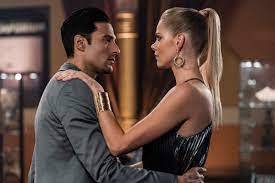
The video analyzes Isobel’s discovery that Noah had been physically and mentally manipulating her throughout their entire marriage, as well as her journey to self acceptance. This is an extremely significant storyline in season 1 and is essential to the development of Isobel’s character in the future seasons.
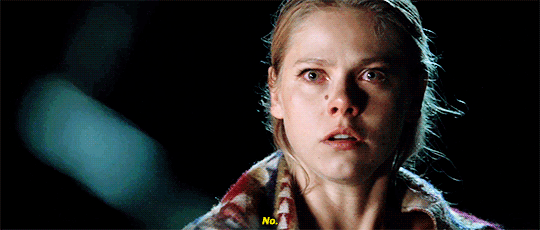
To me, the most powerful part of this video is the song choice of “Praying” by Kesha. The lyrics detail the the songwriter’s own experience in an abusive relationship and how she has come to terms with her new independence. This perfectly encompasses Isobel’s journey, because while the idea of “alien manipulation” is fiction, the violation and self-deprecation that she endured is certainly not. These lyrics therefore create a bridge between Isobel’s hurt in an alien world and those in the audience that are experiencing similar suffering in the real world. The video also perfectly times the lyrics of the song to correlate to certain moments in Isobel’s self discovery. For example, the words “you almost had me fooled” plays as clips of Isobel and Noah “happily” together sequentially play. Again, the video pictures Liz telling Isobel that it is okay for her to grieve and find herself again as the lyrics “I am proud of who I am” play in the background. I appreciate this keen attention to detail, because it is imperative to the storytelling aspect of the video.
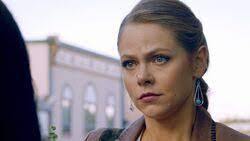
Additionally, the video utilizes voice-overs to supplement the clips that play from the show. The most significant example of this is at the beginning of the video, which has Liz talking to Isobel, saying “I won't pretend to know what you’re going through. You were violated in a way that is unimaginable.” This voice-over continues throughout the video in order to demonstrate the reflection that Isobel must undergo after Noah is finally gone. While most of the video contains clips from Isobel interacting with Noah when he was still alive, the voice-overs foreshadow the growth that Isobel uncovers once she is able to escape his harmful control. Although it is common for fan videos to include music without words, I think that the dialogue from the clips is essential to conveying the intense emotions, especially alongside the song lyrics.
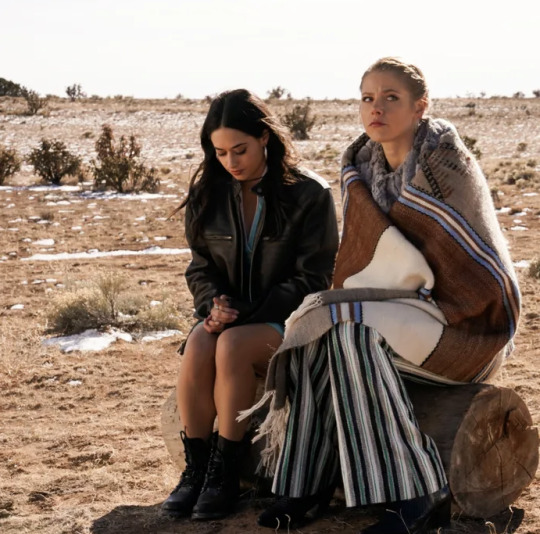
It is evident that the creator took great care in deliberately choosing which scenes from the show to use. Each clip contributes to the Isobel’s overall journey, which include both flashbacks and realtime clips from season 1. For instance, the inclusion of both Isobel killing Rosa under Noah’s control and Isobel realizing 10 years later what had happened demonstrates the parallelism of these scenes. In both instances, Isobel puts a hand over her mouth, or Rosa’s, mouth, but in very different emotional responses. This attention to detail is what makes this video particularly powerful to me.
0 notes